Magnetoelectric Interactions in Lead-Based and Lead-Free Composites
Abstract
:1. Introduction
pDk = pdki pTi + pεkn pEn
mBk = mqki mTi + mμkn mHn
Dk = dkiTi + εknEn + αkn Hn
Bk = qkiTi + αknEn + μknHn
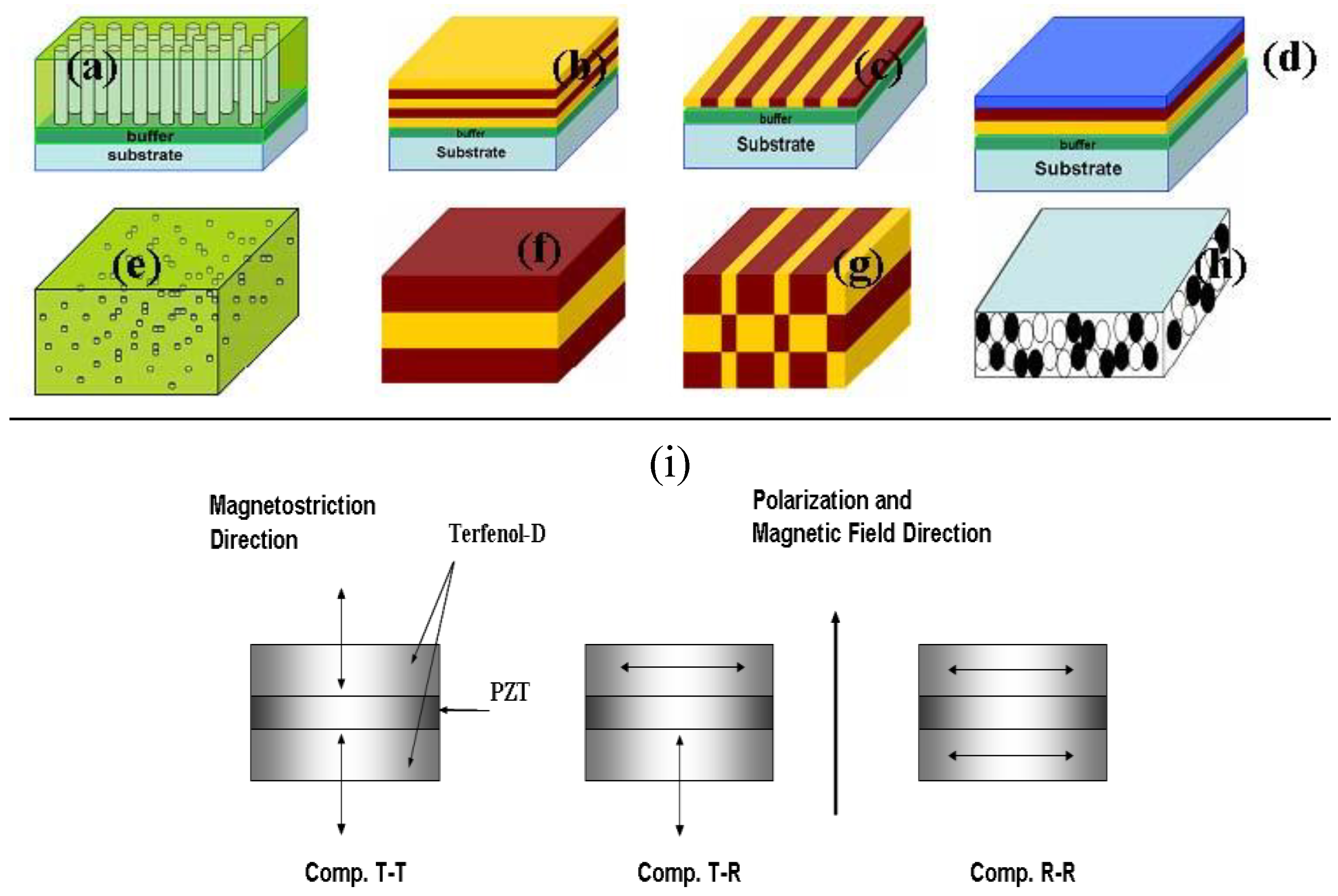
2. Progress on Lead–Free Piezoelectric Materials
2.1. NBT-BT Lead-Free Piezoelectric
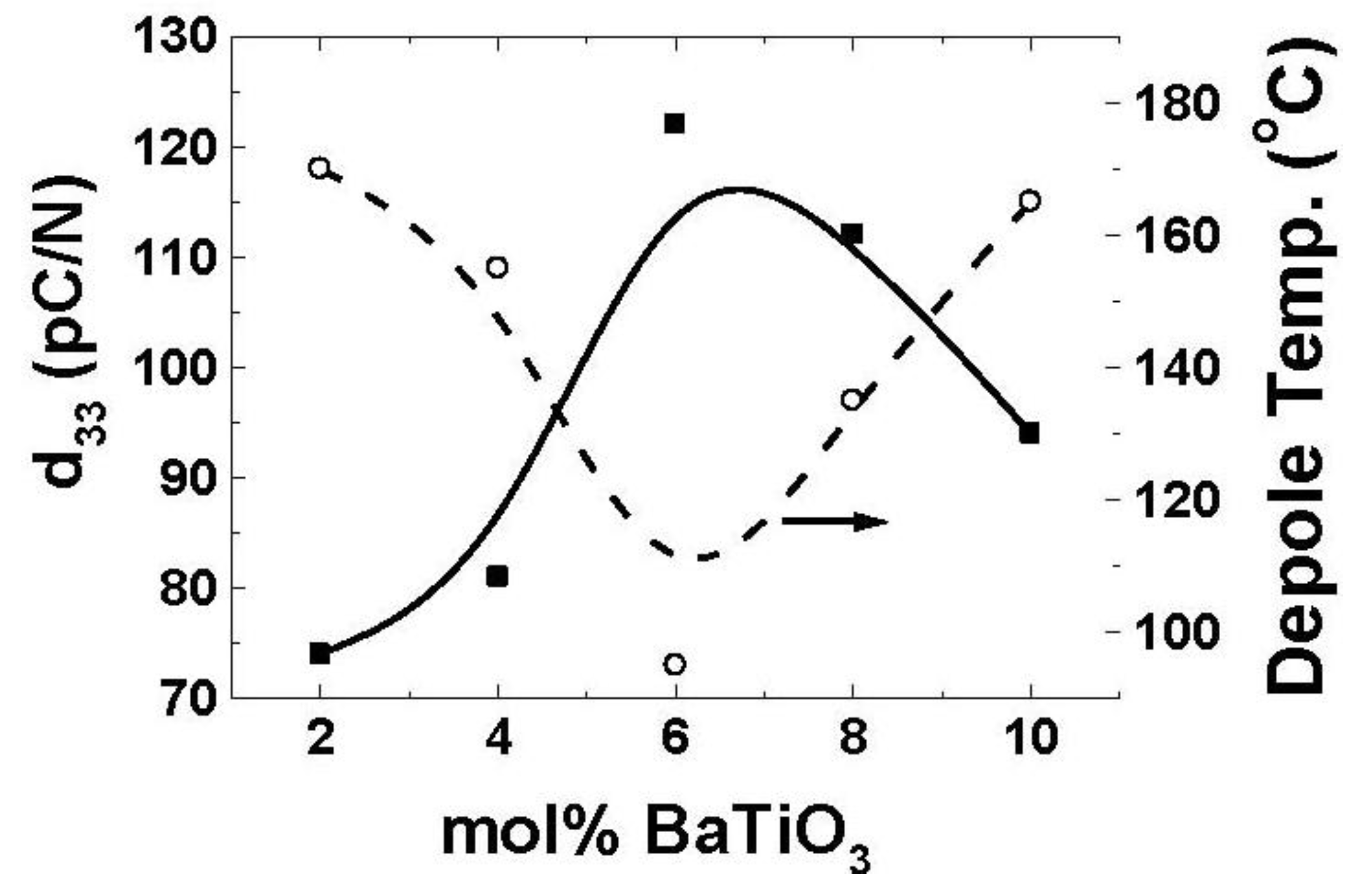
2.2. NKN Based Lead-Free Piezoelectric
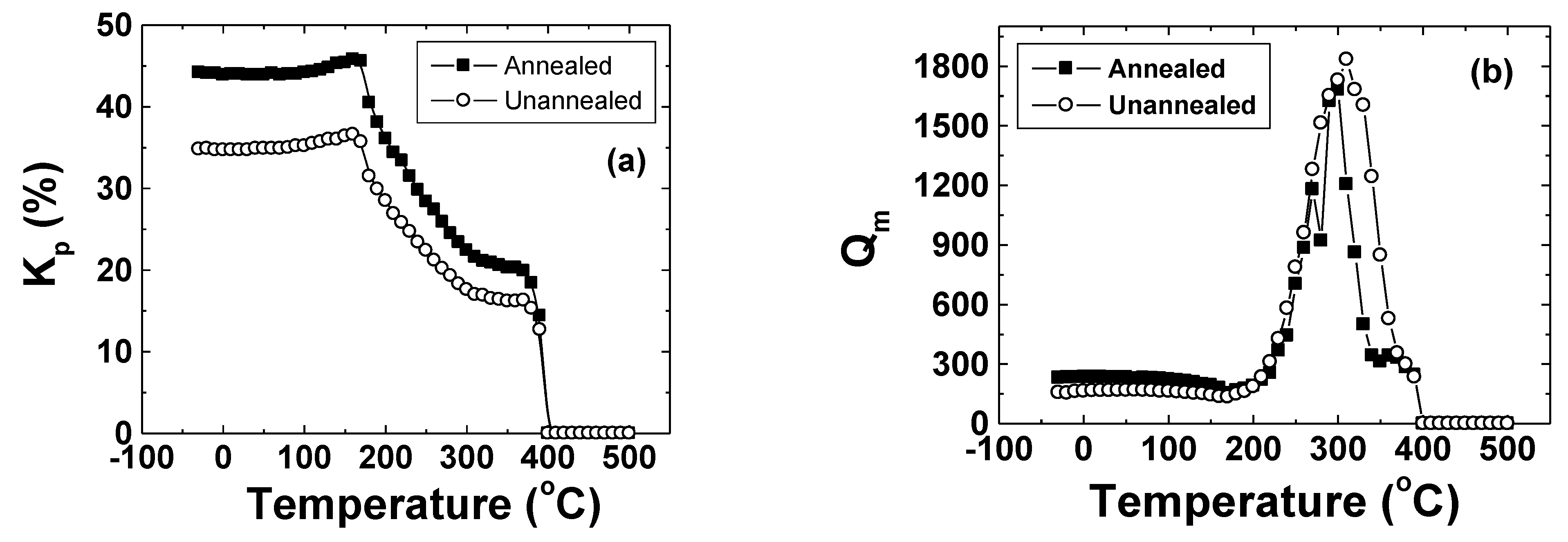
| Materials | d33 | kp | k33 | Tc | To–t/Td | Reference |
|---|---|---|---|---|---|---|
| BaTiO3 | 190 | 0.36 | 0.5 | 115 | 0 | [116] |
| BT-BCN | 330 | 0.43 | 80 | -- | [117] | |
| NBT-KBT-LBT | 216 | 0.401 | 350 | 160 | [118] | |
| NBT-KBT-BT | 183 | 0.367 | 0.619 | 290 | 100 | [119] |
| NBT-xBT; x = 6–8% | 122–176 | 0.21–0.36 | 225–228 | 90–105 | [87,120,121,122,123,124] | |
| NBT-6BT+7.5L | 208 | 0.368 | 260 | 85 | [125,126] | |
| NBT-6BT-2NKN | 30 | 260 | [100,101] | |||
| NBT-20KBT (MPB) | 140–190 | 0.27–0.35 | 280–300 | 130–170 | [127,128,129,130,131,132] | |
| (K0.5Na0.5)NbO3 (H.P.) | 127 | 0.46 | 0.6 | 420 | [107,108] | |
| (K0.5Na0.5)NbO3 | 80 | 0.35 | 0.51 | 420 | 195 | [133] |
| NKN-Li (7%) | 240 | 0.45 | 0.64 | 460 | ~20 | [134] |
| NKN-LF4(Textured) | 410 | 0.61 | - | 253 | 25 | [91,135] |
| NKN-SrTiO3 (5%) | 200 | 0.37 | - | 277 | 27 | [67,68] |
| NKN-LiTaO3 (5%) | 200 | 0.36 | - | 430 | 55 | [63] |
| NKN-LiNbO3 (6%) | 235 | 0.42 | - | 460 | 70 | [62] |
| NKN-LiSbO3 (5%) | 283 | 0.50 | - | 392 | 45 | [64] |


3. Modeling of Piezoelectric Materials
3.1. Single Domain Approximation in Computing the Piezoelectric Coefficients of Ferroelectrics
3.1.1. Lead Titanate
3.1.2. Barium Titanate
3.1.3. LiTaO3
3.1.4. KNbO3
| Coefficients | PbTiO3 | BaTiO3 | LiTaO3 | KNbO3 | (Na,K)NbO3 | Na0.5Bi0.5TiO3-BaTiO3 |
|---|---|---|---|---|---|---|
| a1 | 3.8 × 105 (Т − 479) | 4.124 × 105 (T − 115) | 1.256 × 109 | 4.273 × 105 (T − 377) | ||
| a11 (a2) | −7.3 × 107 | 5.328 × 108 | 5.043 × 109 | 6.36 × 108 | ||
| a12 | 9.66 × 108 | |||||
| a111 | 2.6 × 108 | 1.294 × 109 | 2.81 × 109 | |||
| a112 | −1.99 × 109 | |||||
| a123 | 6.03 × 109 | |||||
| a1111 | 3.863 × 1010 | 1.74 × 1010 | ||||
| a1112 | 5.99 × 109 | |||||
| a1122 | 2.50 × 1010 | |||||
| a1123 | −1.17 × 1010 |
| B | PbTiO3 | BaTiO3 | LiTaO3 | KNbO3 | (Na,K)NbO3 | Na0.5Bi0.5TiO3-BaTiO3 | ||||||
| Theory | Obser-vation | Theory | Obser-vation | Theory | Obser-vation | Theory | Obser-vation | Theory | Obser-vation | Theory | Obser-vation | |
| Ps (С/m2) | 1.5 | 0.26 | 0.26 | 0.5 | 0.45 | 0.42 | ||||||
| ε33/ε0 | 75 | 189 | 188 | 46 | 55 | |||||||
| ε22/ε0 | 160 | |||||||||||
| ε11/ε0 | 1000 | |||||||||||
| d31 (10−12m/V) | −11 | −37 | −29.4 | 1.0 | 3.4 | 9.8 | ||||||
| d32 (10−12m/V) | −24.3 | −22.3 | ||||||||||
| d33 (10−12m/V) | 22 | 25 | 95 | 86.3 | −2.5 | 27.4 | 29.3 | |||||
3.2. Theory of Ferroelectric Solid Solutions (Generalized Lattice Model) [149,150,151,152]
3.2.1. Effective Fields
3.2.2. Generating Functional and Polarization of Solution
3.2.3. Mean Value of a Single Particle Dipole Moment in Effective Field
3.2.4. Polarization of Solid Solution
3.2.5. Parameters of the Components
3.2.6. Susceptibility of Solid Solution
3.2.7. Critical Points of Solid Solutions and Model Parameters
3.2.8. System Ba1−xPbxTiO3
| x | 0 | 0.5 | 1.0 |
| T(x) | 393 K | 623 K | 763 K |
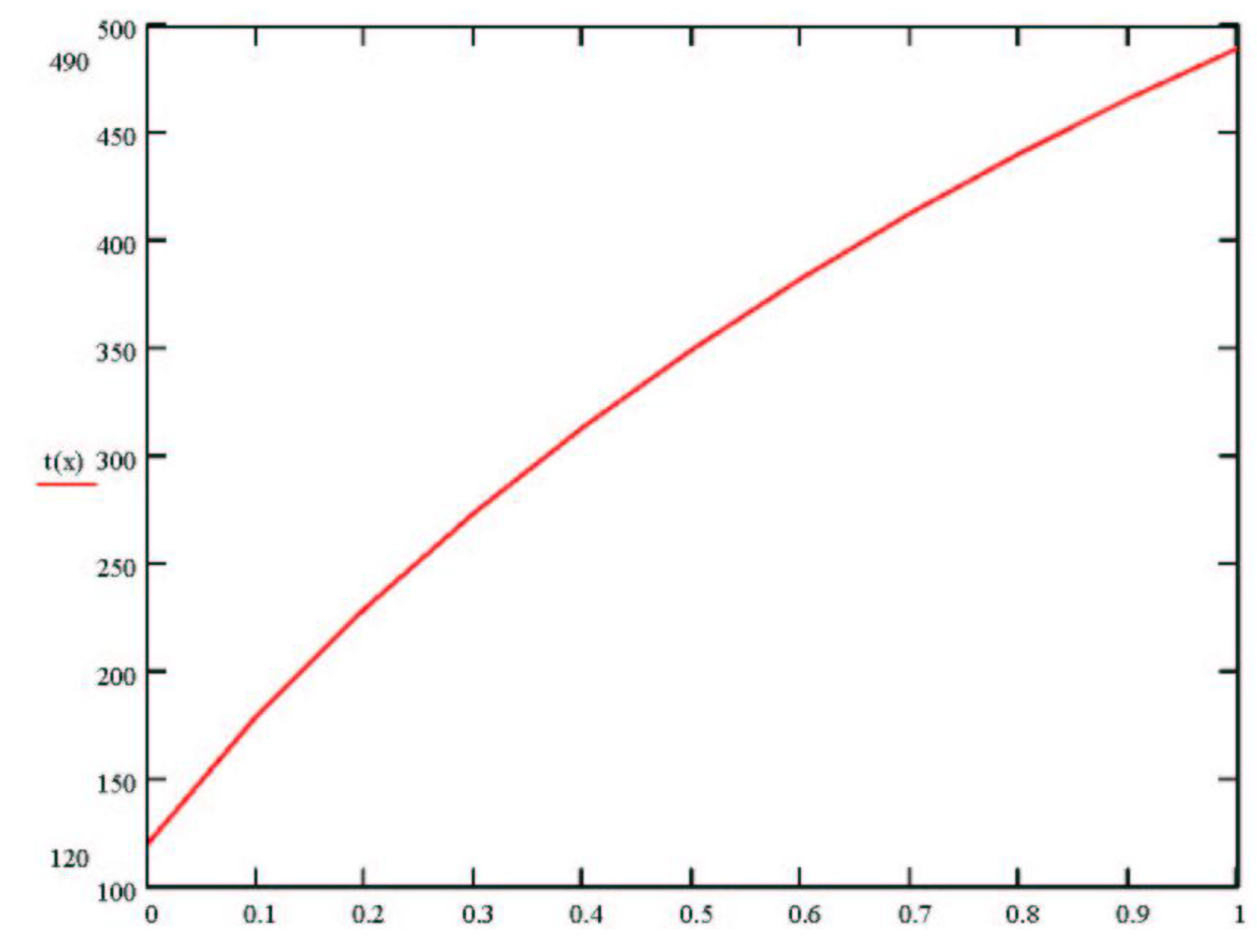
4. Modeling of Magnetoelectric Composites
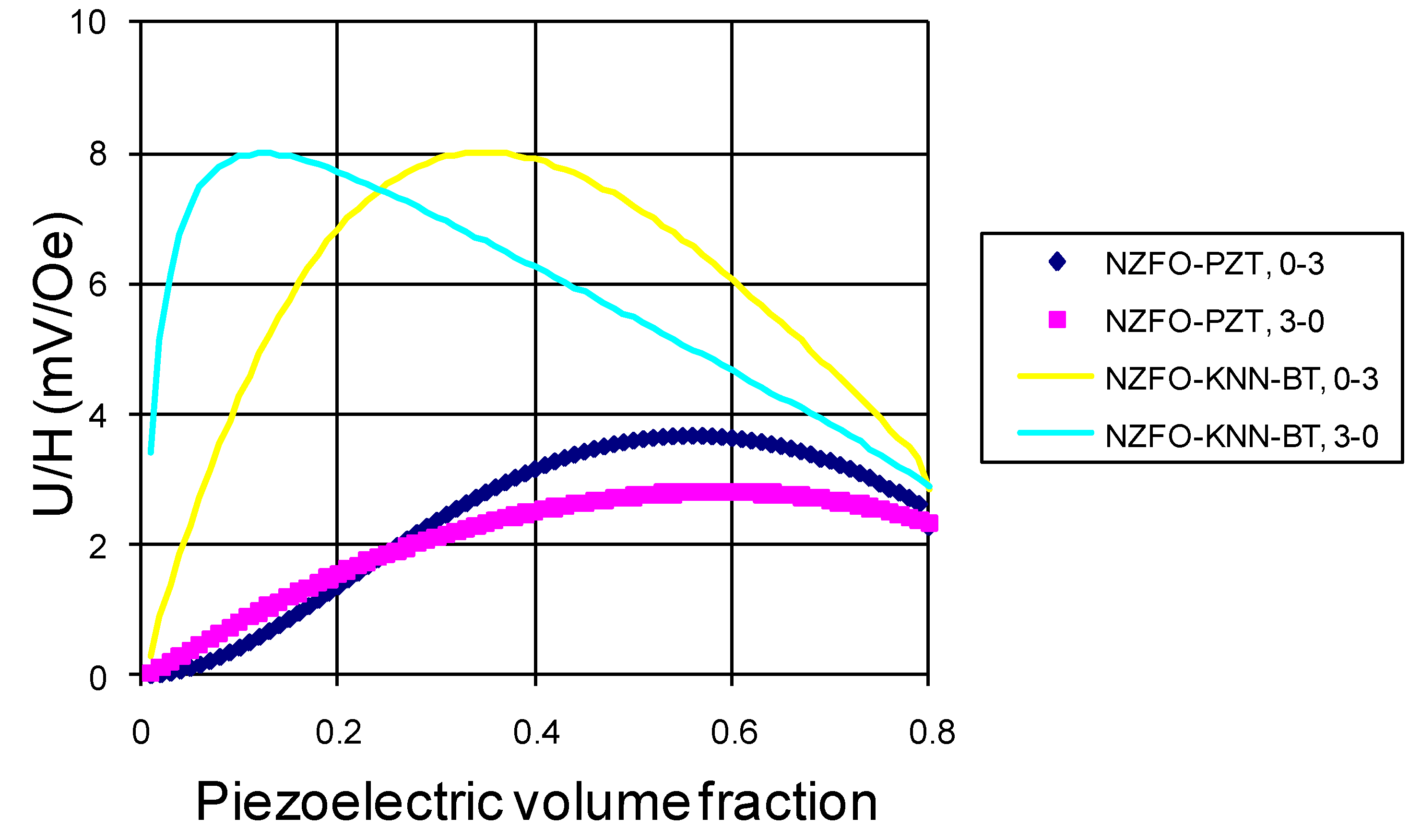
pDk = pdki pTi + pεkn pEn
| Material | s11 (10−12 m2/N) | s12 (10−12 m2/N) | q11 (10−12 m/A) | q12 (10−12 m/A) | d31 (10−12 m/V) | d33 (10−12 m/V) | ε33/ε0 |
|---|---|---|---|---|---|---|---|
| PZT | 17.3 | −7.22 | - | - | −175 | 400 | 1750 |
| NBT-BT | 7.3 | −3.2 | - | - | −140 | 280 | 2000 |
| Mn:NBT-BT | 7.3 | −3.2 | −242 | 483 | 4000 | ||
| NKN-BT | 5.55 | −1.04 | −110 | 225 | 1058 | ||
| NZFO | 6.5 | −2.4 | −1050 | 210 | - | ||
| CFO | 6.5 | −2.4 | −1880 | 556 | |||
| Ni | 4.9 | −1.5 | −4140 | 570 |
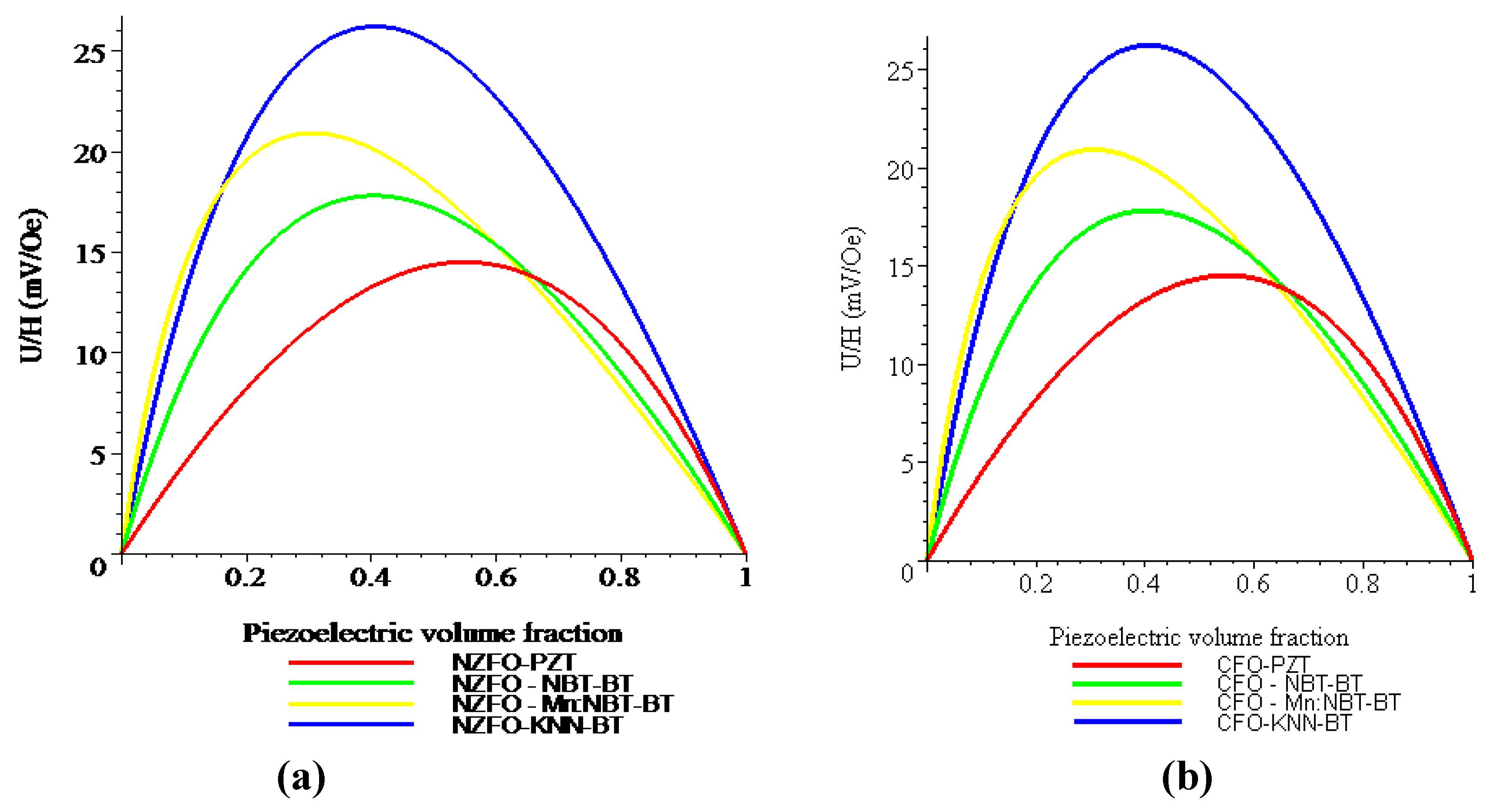
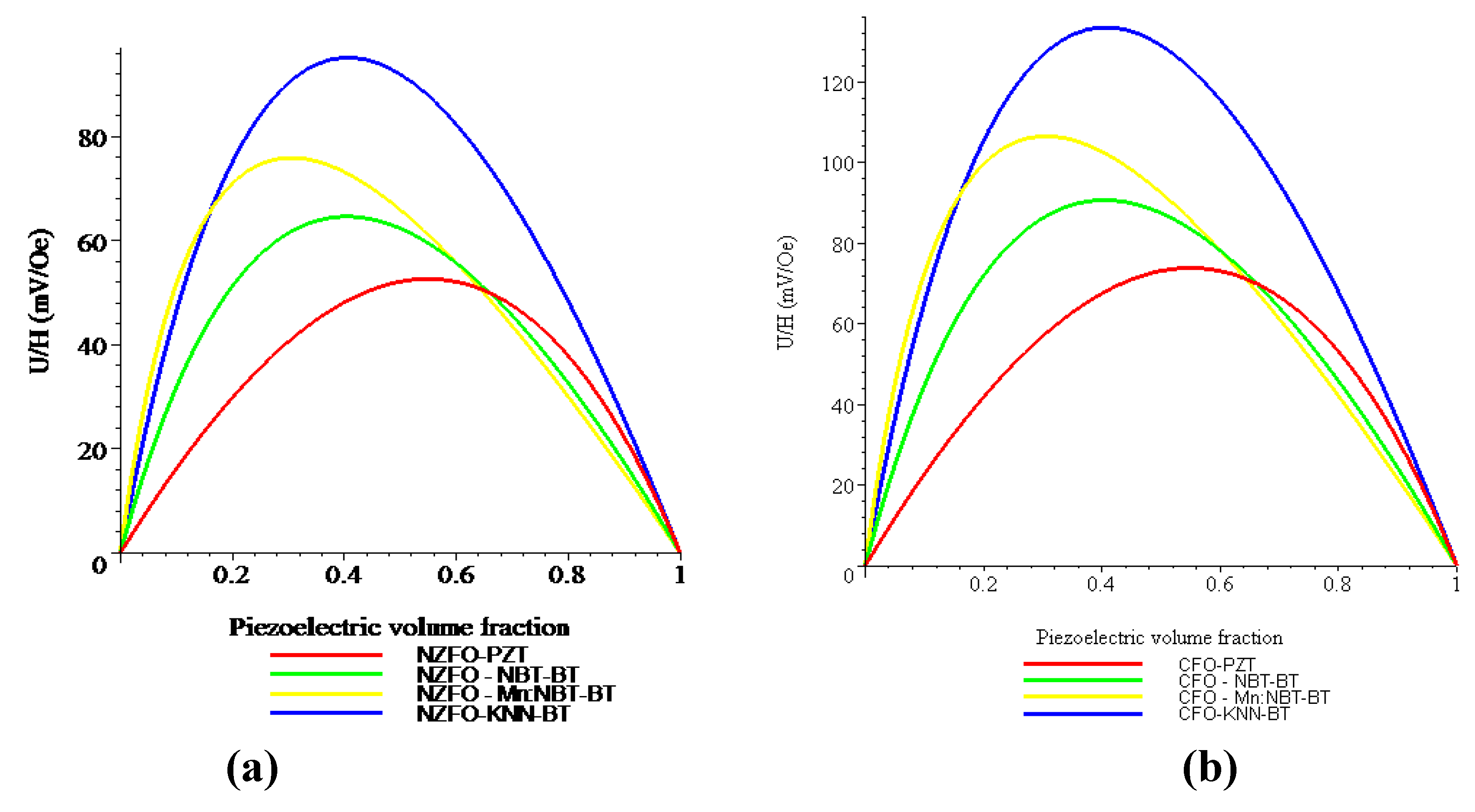
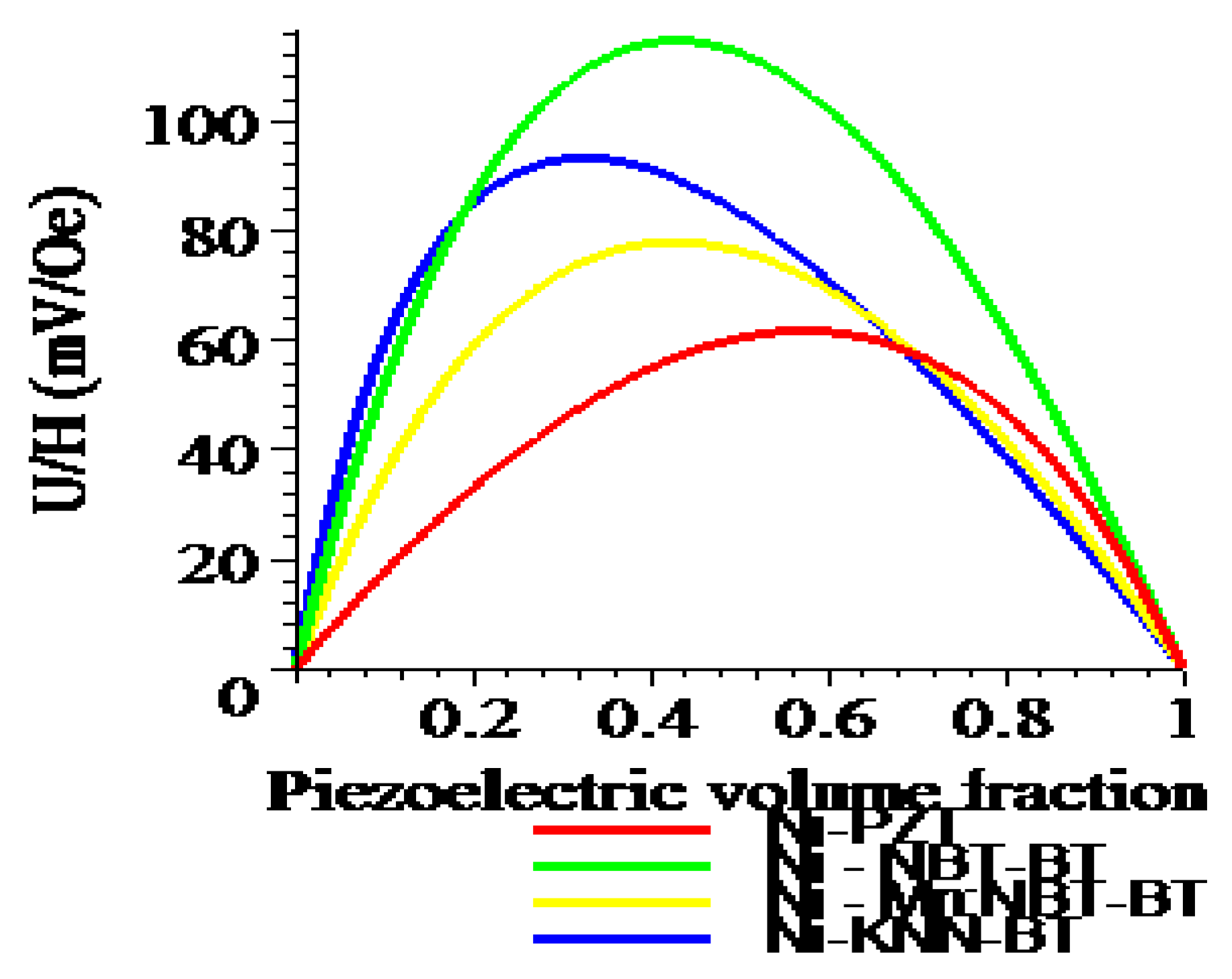
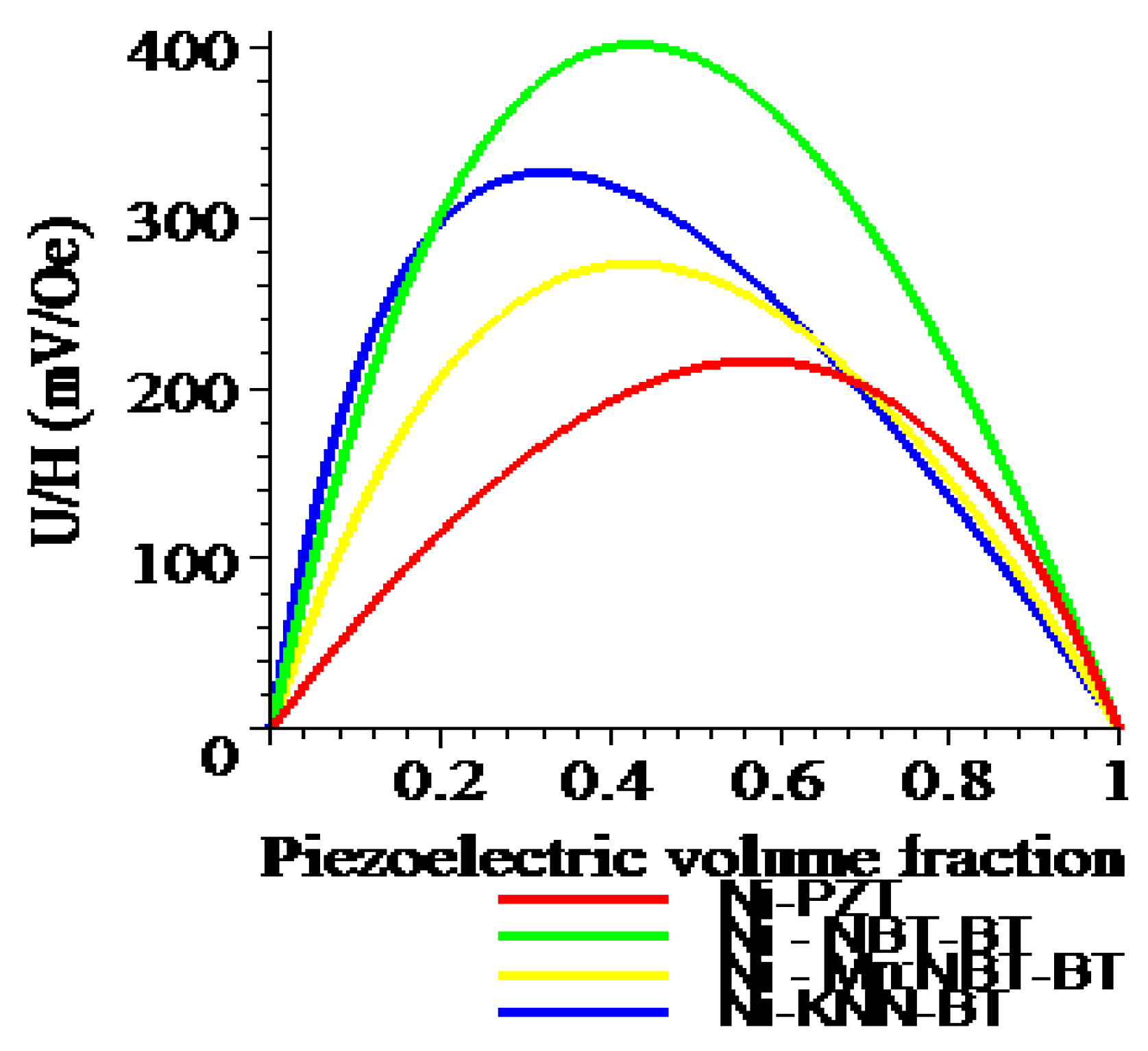
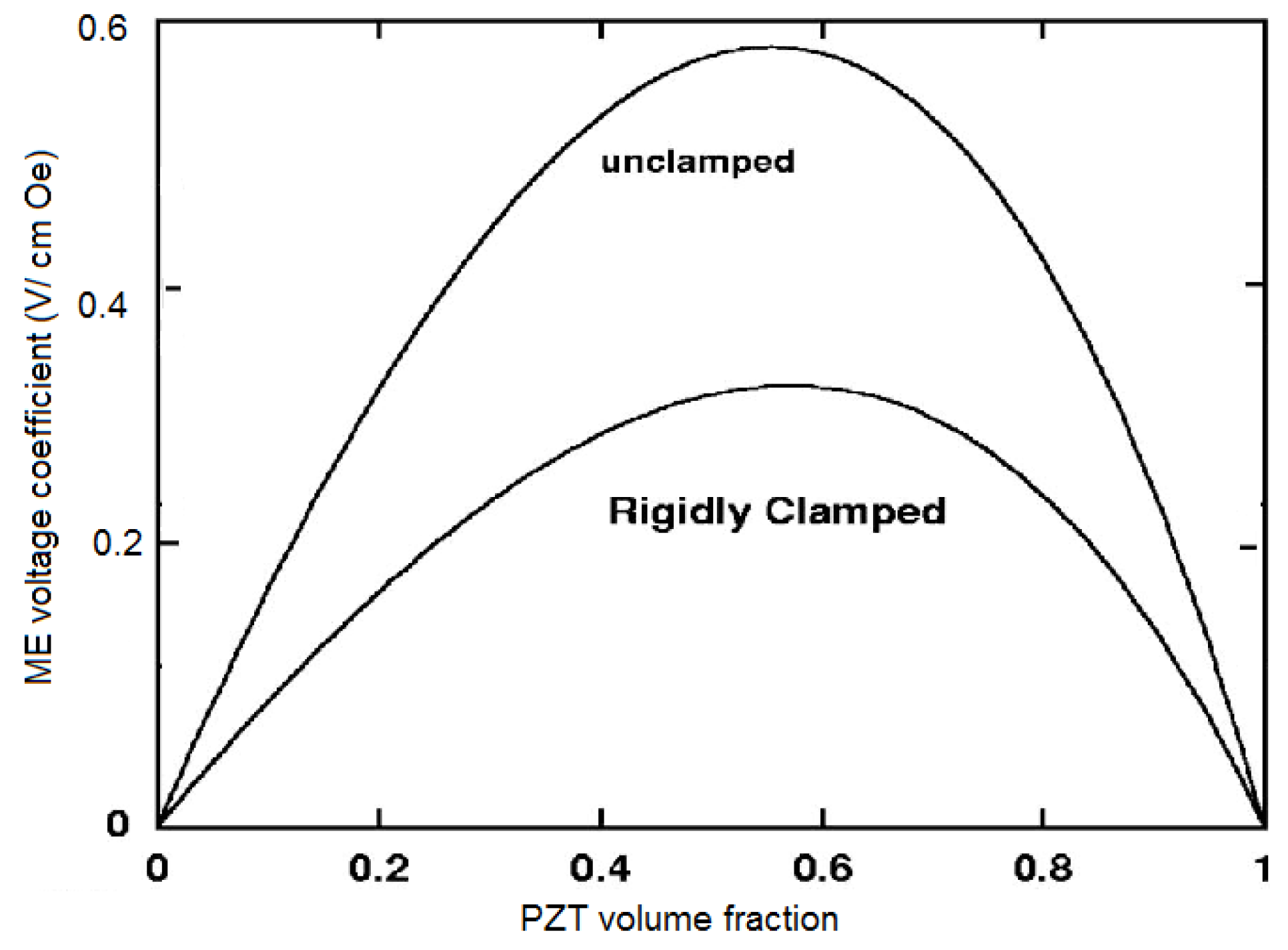
5. Data on Magnetoelectric Response in 3-0, 2-2, and 1-3 Composites
5.1. ME Effect in Sintered Composites
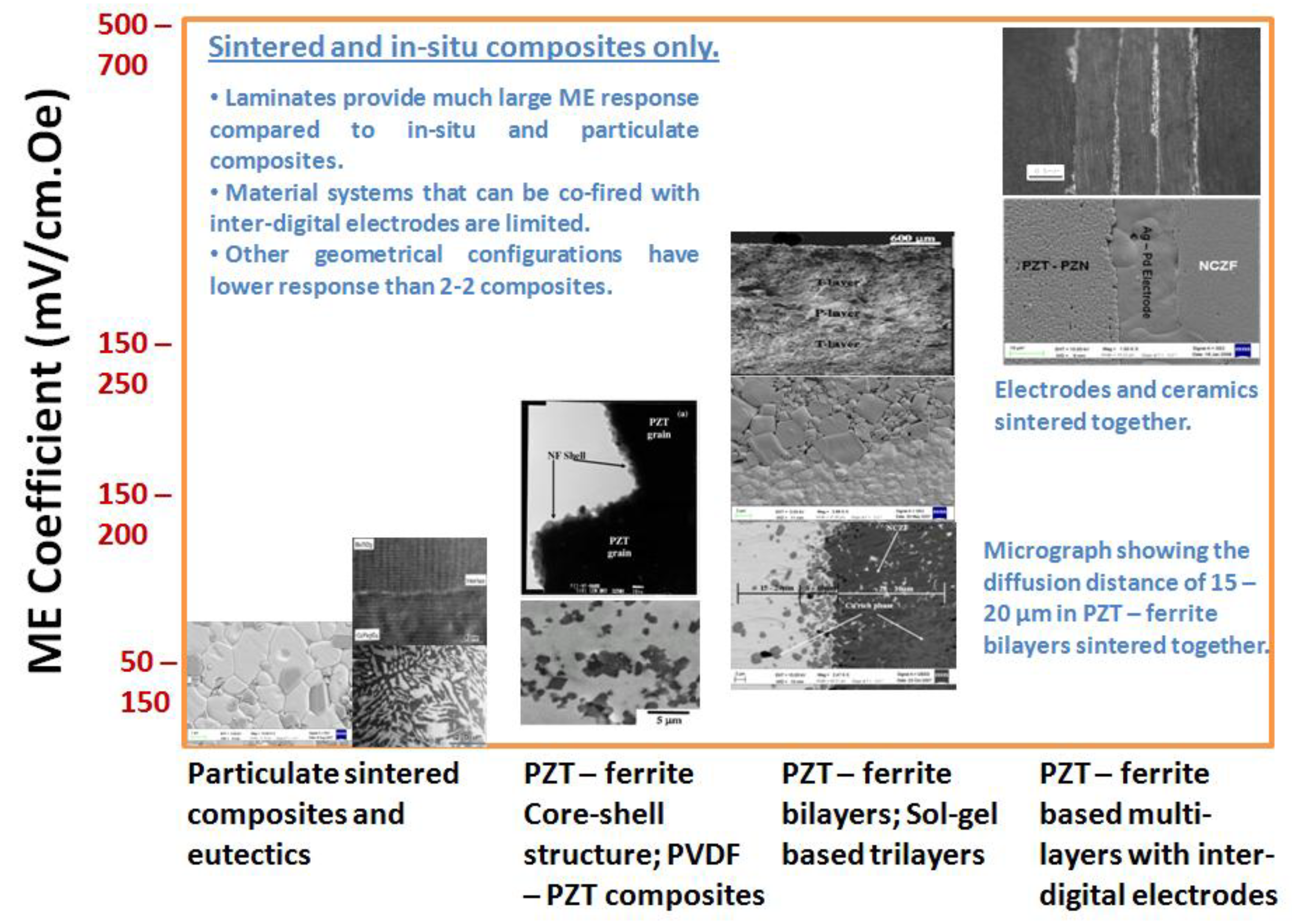
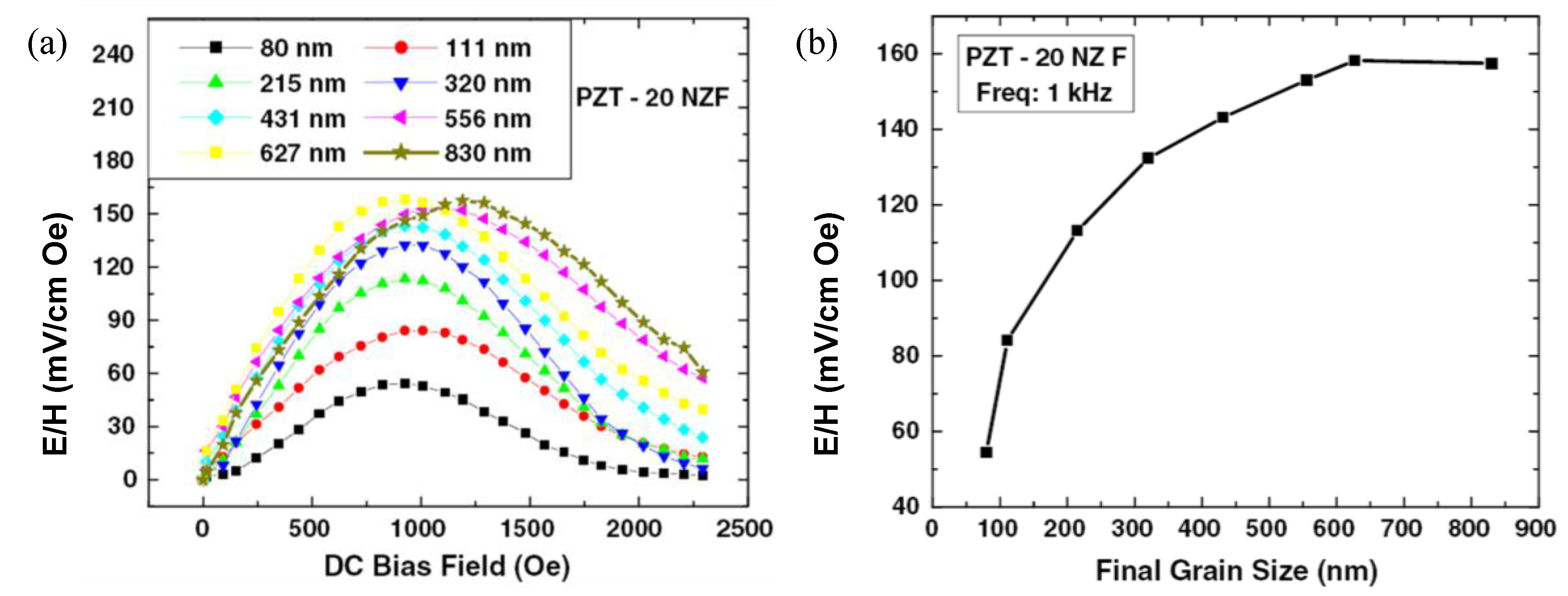
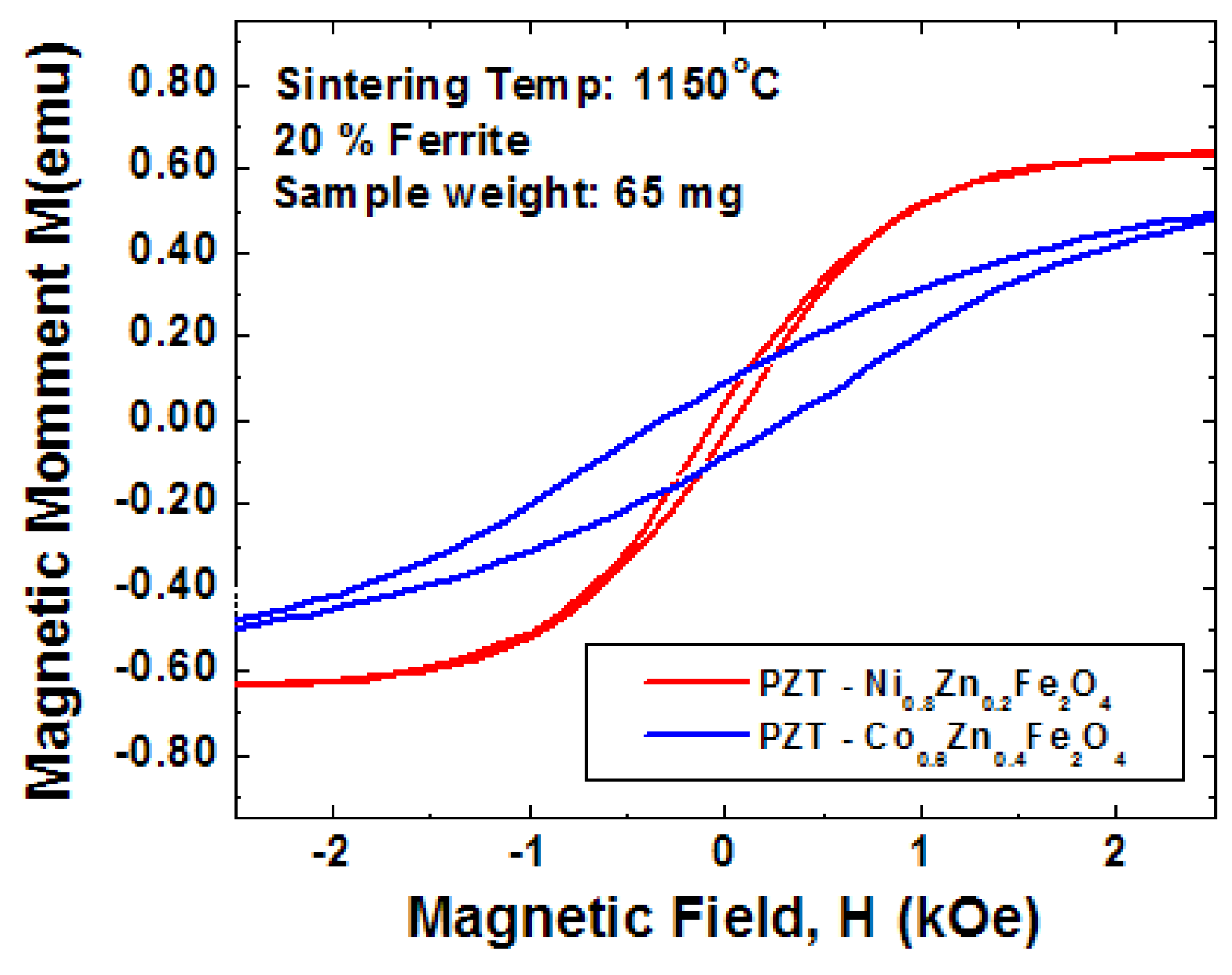

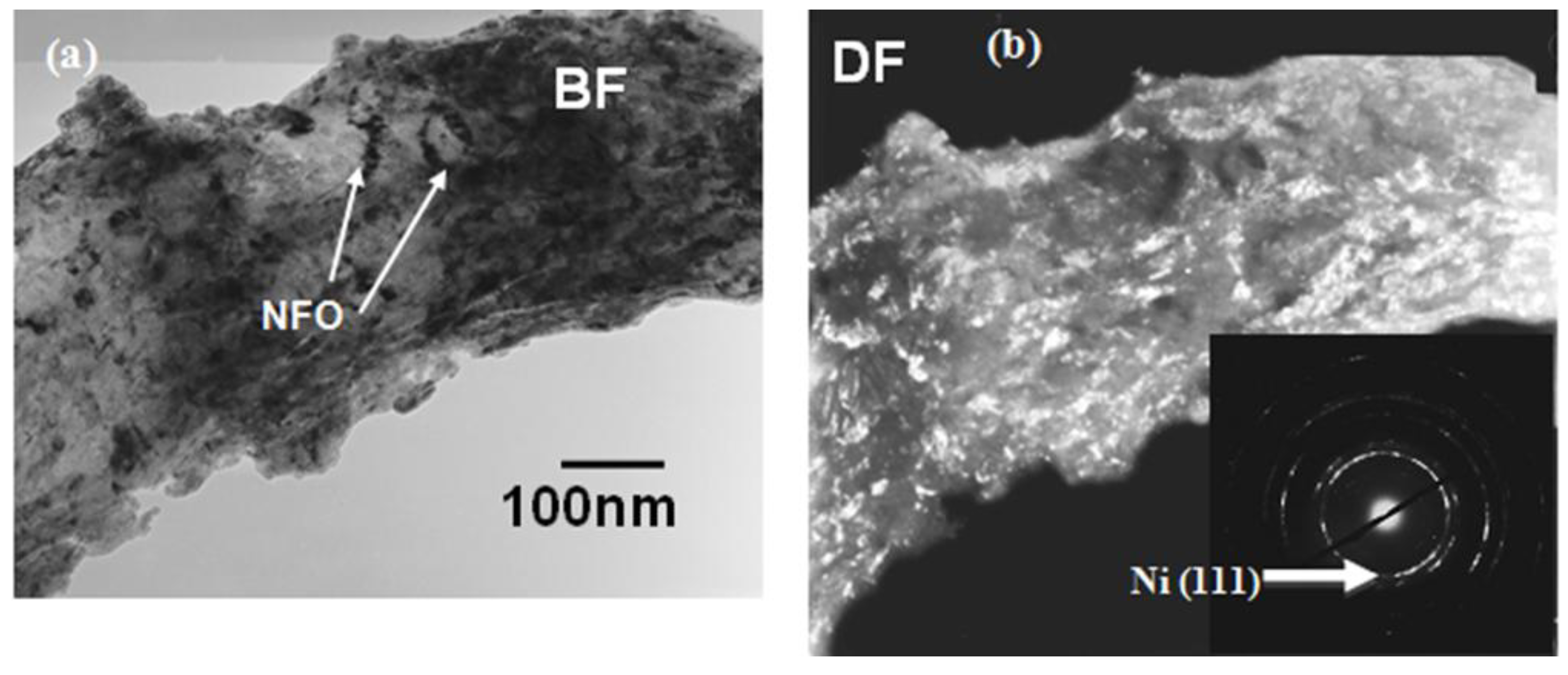

5.2. ME Effect in 2-2 Composites

| Material | |
| MnFe2O4 | −5 |
| Fe3O4 | 40 |
| CoFe2O4 | −110 |
| MgFe2O4 | −6 |
| Li0.5Fe2.5O4 | −8 |
| NiFe2O4 | −26 |
| CuFe2O4 | −9 |
| YFe5O12 | −2 |
| SmFe5O12 | 3.3 |
| DyFe5O12 | 1.46 |
| EuFe5O12 | 9.48 |



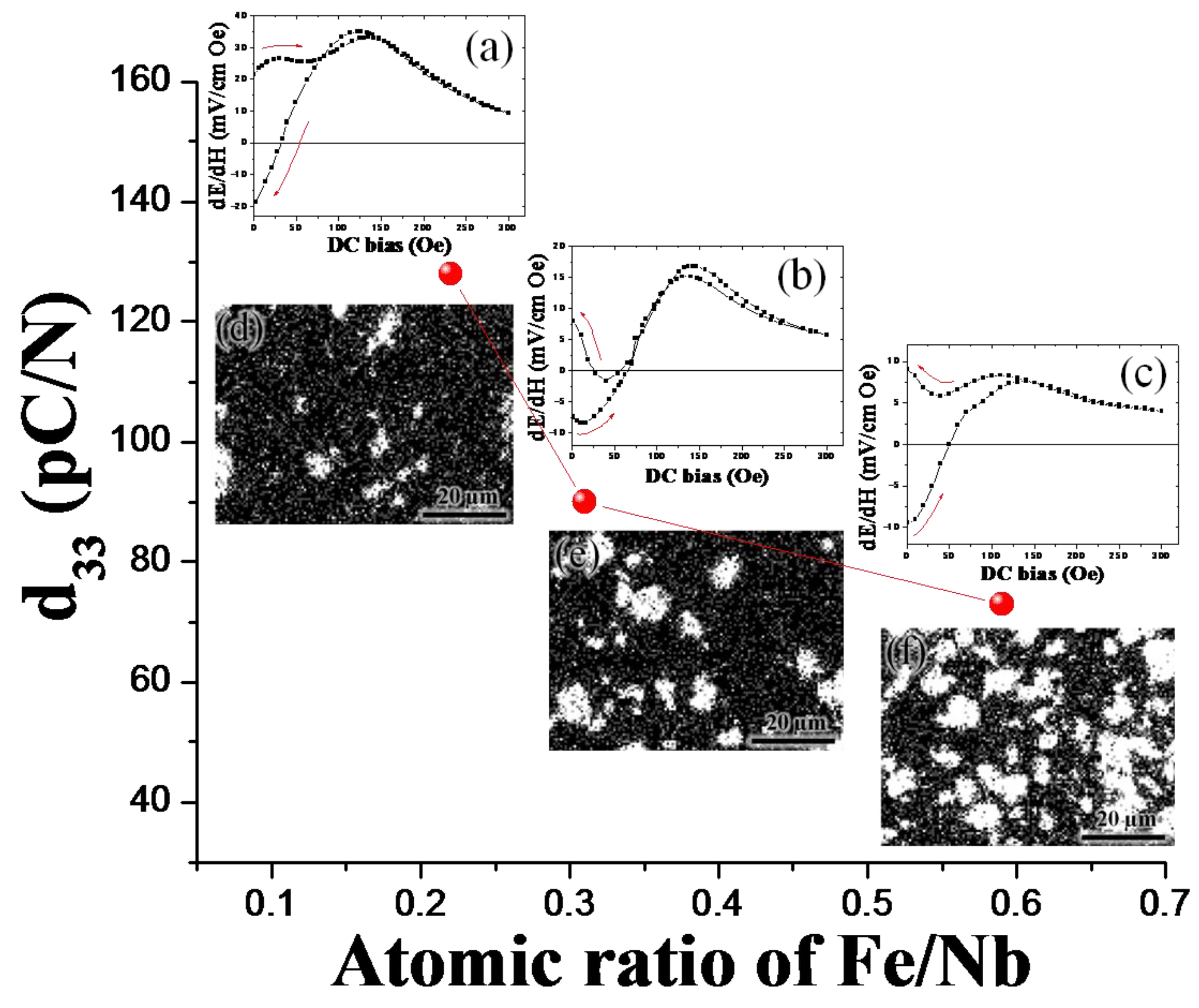
5.3. ME Effect in 1-3 Composites
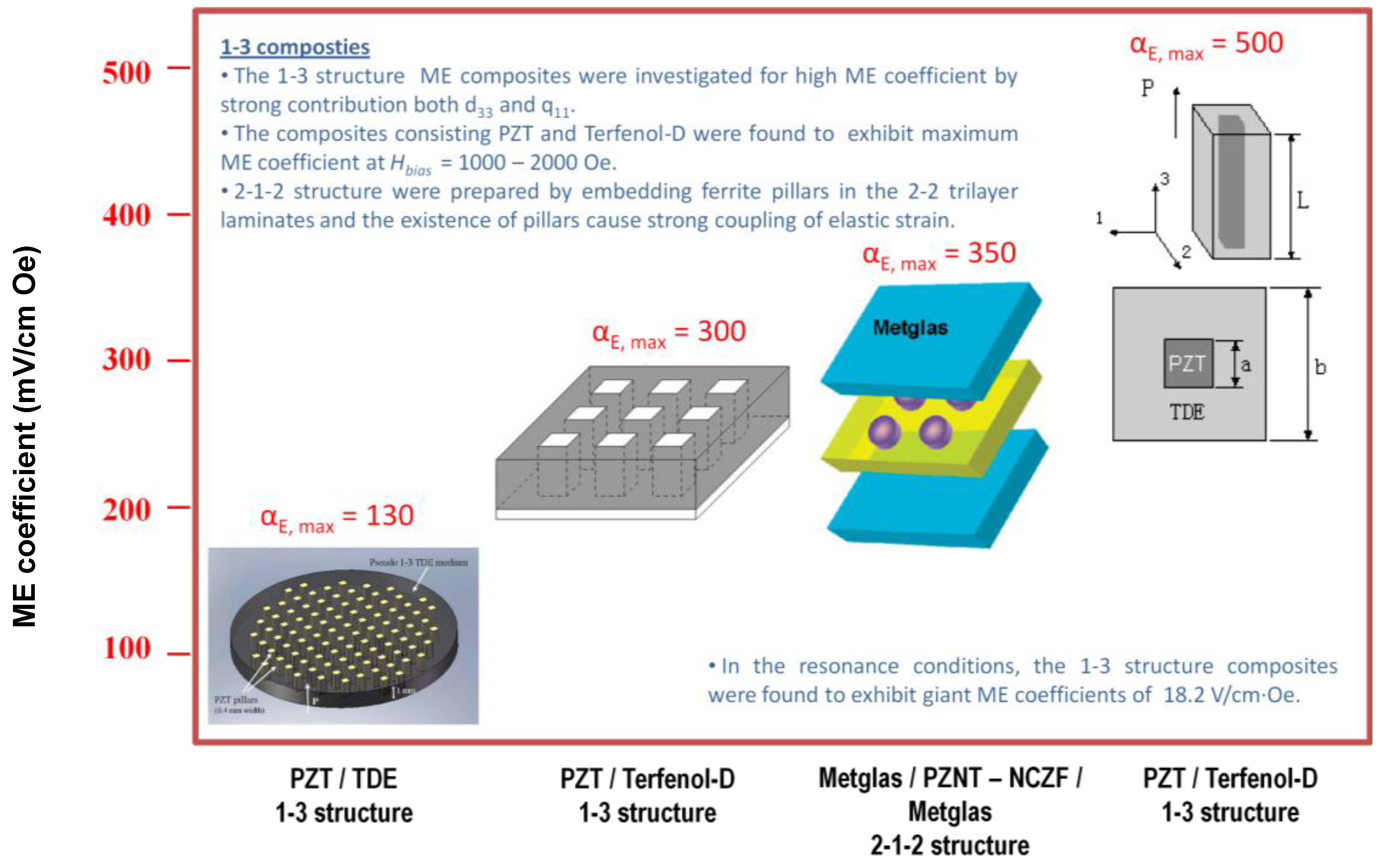
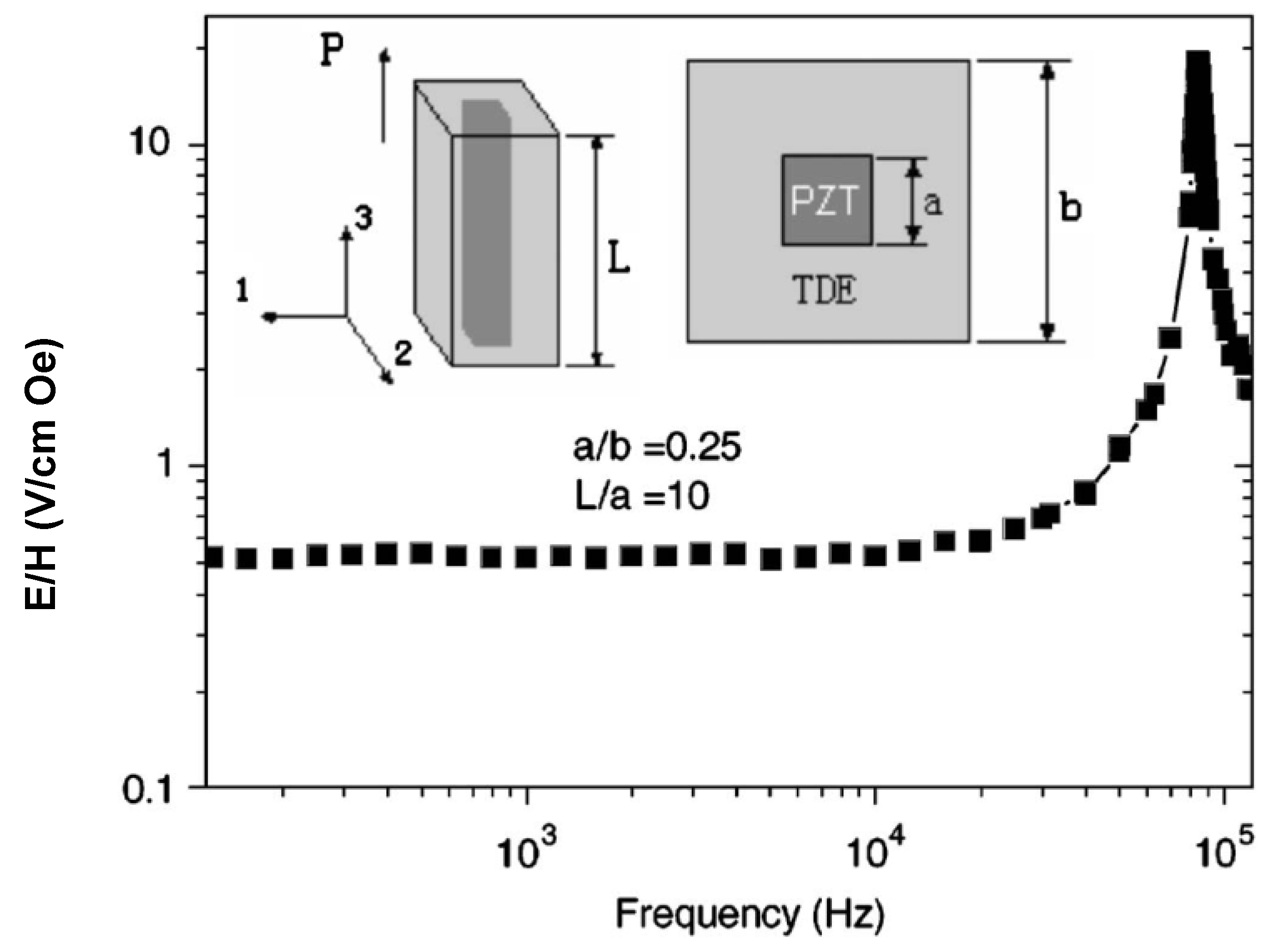
pur = mur and pTr = mTr at r = pR
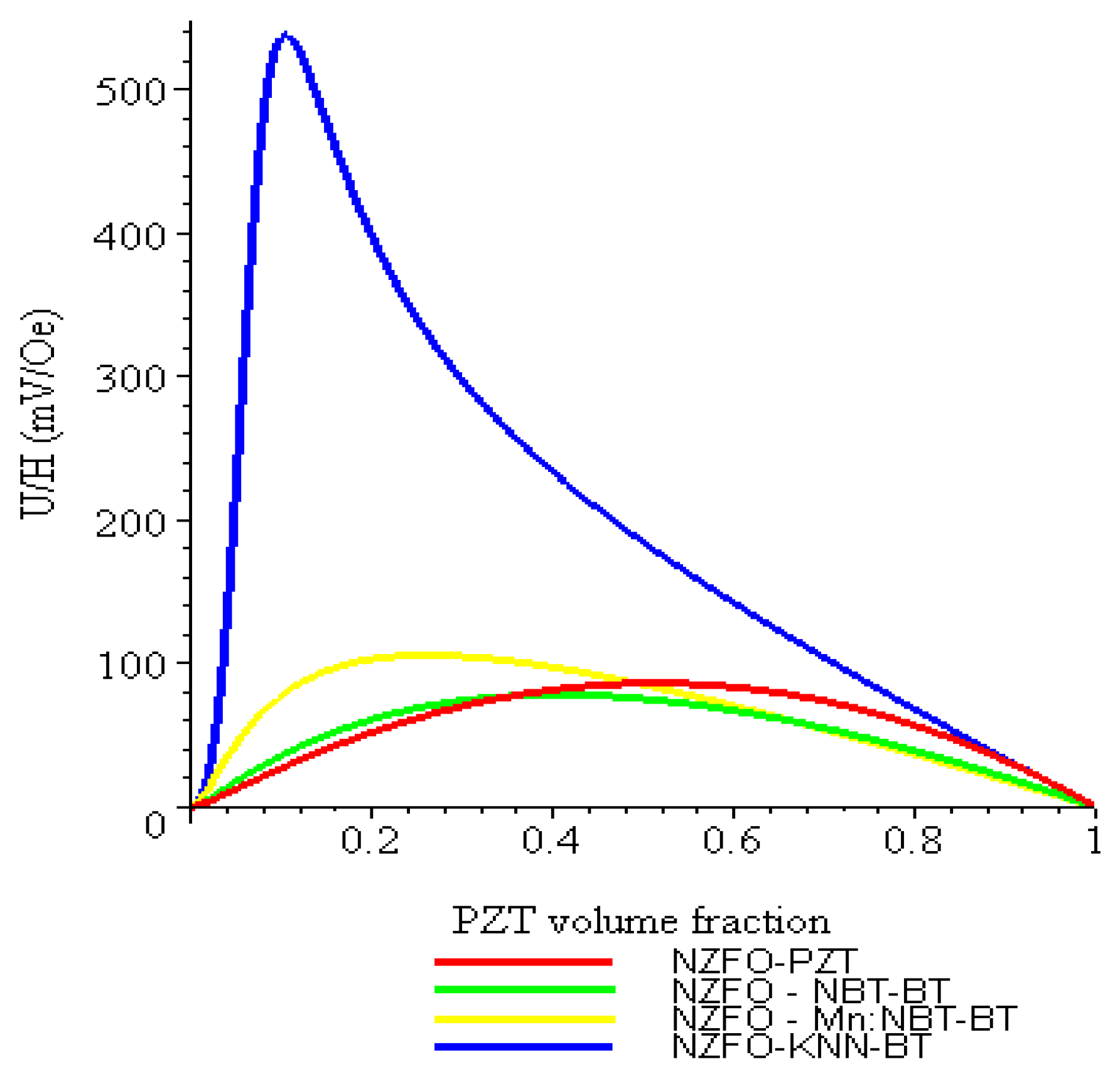

6. Conclusions
Acknowledgments
References
- Van Suchetelen, J. Product Properties: A new application of composite materials. Philips Res. Rep. 1972, 27, 28–37. [Google Scholar]
- Smolenskii, G.; Ioffe, V.A. Communication No. 71. Colloque Int. du Magnetisme Grenoble 1958, 71–75.
- Astrov, D.N.; Aleshin, B.I.; Zorin, R.V.; Drobyshev, L.A. On spontaneous magnetoelectric effect. Sov. Phys. JETP 1968, 28, 1123–1127. [Google Scholar]
- Fiebig, M. Revival of the magnetoelectric effect. J. Phys.-D-Appl. Phys. 2005, 38, R123–R152. [Google Scholar] [CrossRef]
- Bichurin, M.I.; Petrov, V.M.; Petrov, R.V.; Kapralov, G.N.; Kiliba, Y.V.; Bukashev, F.I.; Smirnov, A.Y.; Tatarenko, A.S. Magnetoelectric microwave devices. Ferroelectrics 2002, 280, 377–384. [Google Scholar]
- Nan, C.W.; Bichurin, M.I.; Dong, S.X.; Viehland, D.; Srinivasan, G. Multiferroic magnetoelectic composites: Historical perspective, status, and future directions. J. Appl. Phys. 2008, 103, 031101:1–031101:35. [Google Scholar]
- Hornreich, R.M. The magnetoelectric effect: Some likely candidates. Solid State Commun. 1969, 7, 1081–1085. [Google Scholar] [CrossRef]
- Bichurin, M.I.; Petrov, V.M.; Srinivasan, G. Theory of low-frequency magnetoelectric coupling in magnetostrictive-piezoelectric bilayers. Phys. Rev. B 2003, 68, 054402:1–054402:13. [Google Scholar]
- Fischer, E.; Gorodetsky, G.; Hornreich, R.M. A new family of magnetoelectric materials: A2M4O9 (A = Ta, Nb; M = Mn, Co). Solid State Commun. 1972, 10, 1127–1132. [Google Scholar] [CrossRef]
- Suryanarayana, S.V. Magnetoelectric interaction phenomena in materials. Bull. Mater. Sci. 1994, 17, 1259–1270. [Google Scholar] [CrossRef]
- Srinivas, A.; Kim, D.W.; Hong, K.S.; Suryanarayana, S.V. Study of magnetic and magnetoelectric measurements in bismuth iron titanate ceramic-Bi8Fe4Ti3O24. Mater. Res. Bull. 2004, 39, 55–61. [Google Scholar] [CrossRef]
- Van den Boomgaard, J.; Terrell, D.R.; Born, R.A.; Giller, H.F. An in situ grown eutectic magnetoelectric composite material. Mater. Sci. 1974, 9, 1705–1709. [Google Scholar] [CrossRef]
- Van den Boomgaard, J.; Born, R.A. Sintered magnetoelectric composite-material BaTiO3-Ni(Co,Mn)Fe2O4. J. Mater. Sci. 1978, 13, 1538–1548. [Google Scholar] [CrossRef]
- Dai, Y.R.; Bao, P.; Zhu, J.S.; Wan, J.G.; Shen, H.M.; Liu, J.M. Internal friction study on CuFe2O4/PbZr0.53Ti0.47O3 composites. J. Appl. Phys. 2004, 96, 5687–5690. [Google Scholar] [CrossRef]
- Ruette, B.; Zvyagin, S.; Pyatakov, A.P.; Bush, A.; Li, J.F.; Belotelov, V.I.; Zvezdin, A.K.; Viehland, D. Magnetic-field-induced phase transition in BiFeO3 observed by high-field electron spin resonance: Cycloidal to homogeneous spin order. Phys. Rev. B 2004, 69, 064114:1–064114:7. [Google Scholar]
- Kadomtseva, A.M.; Zvezdin, A.K.; Popov, Y.F.; Pyatakov, A.P.; Vorobev, G.P. Space-time parity violation and magnetoelectric interactions in antiferromagnets. JETP Lett-Engl. Tr. 2004, 79, 571–581. [Google Scholar] [CrossRef]
- Wang, J.; Neaton, J.B.; Zheng, H.; Nagarajan, V.; Ogale, S.B.; Liu, B.; Viehland, D.; Vaithyanathan, V.; Schlom, D.G.; Waghmare, U.V.; Spaldin, N.A.; Rabe, K.M.; Wuttig, M.; Ramesh, R. Epitaxial BiFeO3 multiferroic thin film heterostructures. Science 2003, 299, 1719–1722. [Google Scholar] [CrossRef]
- Kimura, T.; Goto, T.; Shintani, H.; Ishizaka, K.; Arima, T.; Tokura, Y. Magnetic control of ferroelectric polarization. Nature 2003, 426, 55–58. [Google Scholar] [CrossRef]
- Fiebig, M.; Lottermoser, T.; Frohlich, D.; Goltsev, A.V.; Pisarev, R.V. Observation of coupled magnetic and electric domains. Nature 2002, 419, 818–820. [Google Scholar] [CrossRef]
- Ederer, C.; Spaldin, N.A. Magnetoelectrics-A new route to magnetic ferroelectrics. Nat. Mater. 2004, 3, 849–851. [Google Scholar] [CrossRef]
- Hur, N.; Park, S.; Sharma, P.A.; Ahn, J.S.; Guha, S.; Cheong, S.W. Electric polarization reversal and memory in a multiferroic material induced by magnetic fields. Nature 2004, 429, 392–395. [Google Scholar] [CrossRef]
- Lottermoser, T.; Lonkai, T.; Amann, U.; Hohlwein, D.; Ihringer, J.; Fiebig, M. Magnetic phase control by an electric field. Nature 2004, 430, 541–544. [Google Scholar] [CrossRef]
- Van Aken, B.B.; Palstra, T.T.; Filippetti, A.; Spaldin, N.A. The origin of ferroelectricity in magnetoelectric YMnO3. Nat. Mate. 2004, 3, 164–170. [Google Scholar] [CrossRef]
- Srinivasan, G.; DeVreugd, C.P.; Flattery, C.S.; Laletsin, V.M.; Paddubnaya, N. Magnetoelectric interactions in hot-pressed nickel zinc ferrite and lead zirconante titanate composites. Appl. Phys. Lett. 2004, 85, 2550–2552. [Google Scholar] [CrossRef]
- Ryu, J.; Priya, S.; Uchino, K.; Kim, H.E. Magnetoelectric effect in composites of magnetostrictive and piezoelectric materials. J. Electroceram. 2002, 8, 107–119. [Google Scholar] [CrossRef]
- Srinivasan, G.; Rasmussen, E.T.; Hayes, R. Magnetoelectric effects in ferrite-lead zirconate titanate layered composites: The influence of zinc substitution in ferrites. Phys. Rev. B 2003, 67, 014418:1–014418:10. [Google Scholar]
- Srinivasan, G.; Rasmussen, E.T.; Levin, B.J.; Hayes, R. Magnetoelectric effects in bilayers and multilayers of magnetostrictive and piezoelectric perovskite oxides. Phys. Rev. B 2002, 65, 134402:1–134402:7. [Google Scholar]
- Ryu, J.; Carazo, A.V.; Uchino, K.; Kim, H.E. Magnetoelectric properties in piezoelectric and magnetostrictive laminate composites. Jpn. J. Appl. Phys. 2001, 40, 4948–4951. [Google Scholar] [CrossRef]
- Laletin, V.M.; Padubnaya, N.; Srinivasan, G.; Devreugd, C.P. Frequency dependence of magnetoelectric interactions in layered structures of ferromagnetic alloys and piezoelectric oxides. Appl. Phys. A-Mat. Sci. Process. 2004, 78, 33–36. [Google Scholar] [CrossRef]
- Dong, S.X.; Zhai, J.Y.; Li, J.F.; Viehland, D. Small DC magnetic field response of magnetoelectric laminate composites. Appl. Phys. Lett. 2006, 88, 082907:1–082907:2. [Google Scholar]
- Dong, S.X.; Li, J.F.; Viehland, D. Longitudinal and transverse magnetoelectric voltage coefficients of magnetostrictive/piezoelectric laminate composite: Theory. IEEE T. Ultrason. Ferroelectr. 2003, 50, 1253–1261. [Google Scholar] [CrossRef]
- Dong, S.X.; Li, J.F.; Viehland, D. Circumferentially magnetized and circumferentially polarized magnetostrictive/piezoelectric laminated rings. J. Appl. Phys. 2004, 96, 3382–3387. [Google Scholar] [CrossRef]
- Dong, S.X.; Cheng, J.R.; Li, J.F.; Viehland, D. Enhanced magnetoelectric effects in laminate composites of Terfenol-D/Pb(Zr,Ti)O-3 under resonant drive. Appl. Phys. Lett. 2003, 83, 4812–4814. [Google Scholar] [CrossRef]
- Dong, S.X.; Li, J.F.; Viehland, D. A longitudinal-longitudinal mode TERFENOL-D/Pb(Mg1/3Nb2/3)O33-PbTiO3 laminate composite. Appl. Phys. Lett. 2004, 85, 5305–5306. [Google Scholar] [CrossRef]
- Dong, S.X.; Zhai, J.Y.; Xing, Z.P.; Li, J.F.; Viehland, D. Extremely low frequency response of magnetoelectric multilayer composites. Appl. Phys. Lett. 2005, 86, 102901:1–102901:3. [Google Scholar]
- Zhai, J.Y.; Xing, Z.P.; Dong, S.X.; Li, J.F.; Viehland, D. Detection of pico-Tesla magnetic fields using magneto-electric sensors at room temperature. Appl. Phys. Lett. 2006, 88, 062510:1–062510:3. [Google Scholar]
- Dong, S.X.; Li, J.F.; Viehland, D. Vortex magnetic field sensor based on ring-type magnetoelectric laminate. Appl. Phys. Lett. 2004, 85, 2307–2309. [Google Scholar] [CrossRef]
- Dong, S.X.; Li, J.F.; Viehland, D.; Cheng, J.; Cross, L.E. A strong magnetoelectric voltage gain effect in magnetostrictive-piezoelectric composite. Appl. Phys. Lett. 2004, 85, 3534–3536. [Google Scholar] [CrossRef]
- Dong, S.X.; Li, J.F.; Viehland, D. Longitudinal and transverse magnetoelectric voltage coefficients of magnetostrictive/piezoelectric laminate composite: Experiments. IEEE T. Ultrason. Ferroelectr. 2004, 51, 794–799. [Google Scholar] [CrossRef]
- Dong, S.X.; Zhai, J.Y.; Bai, F.M.; Li, J.F.; Viehland, D.; Lograsso, T.A. Magnetostrictive and magnetoelectric behavior of Fe-20 at. % Ga/Pb(Zr,Ti)O-3 laminates. J. Appl. Phys. 2005, 97, 103902:1–103902:6. [Google Scholar]
- Dong, S.X.; Zhai, J.Y.; Wang, N.G.; Bai, F.M.; Li, J.F.; Viehland, D.; Lograsso, T.A. Fe-Ga/Pb(Mg1/3Nb2/3)O3-PbTiO3 magnetoelectric laminate composites. Appl. Phys. Lett. 2005, 87, 222504:1–222504:3. [Google Scholar]
- Jia, Y.M.; Or, S.W.; Chan, H.L.; Zhao, X.Y.; Luo, H.S. Converse magnetoelectric effect in laminated composites of PMN-PT single crystal and Terfenol-D alloy. Appl. Phys. Lett. 2006, 88, 242902:1–242902:3. [Google Scholar]
- Wan, J.G.; Liu, J.M.; Wang, G.H.; Nan, C.W. Electric-field-induced magnetization in Pb(Zr,Ti)O3/Terfenol-D composite structures. Appl. Phys. Lett. 2006, 88, 182502:1–182502:3. [Google Scholar]
- Ryu, J.; Priya, S.; Uchino, K.; Viehland, D.; Kim, H. High magnetoelectric properties in 0.68Pb(Mg1/3Nb2/3)O3-0.32PbTiO3 single crystal and Terfenol-D laminate composite. J. Korean Ceram. Soc. 2002, 39, 813–817. [Google Scholar] [CrossRef]
- Babu, S.N.; Bhimasankaram, T.; Suryanarayana, S.V. Magnetoelectric effect in metal-PZT laminates. Bull. Mater. Sci. 2005, 28, 419–422. [Google Scholar] [CrossRef]
- Laletin, V.M.; Paddubnaya, N.; Srinivasan, G.; De Vreugd, C.P.; Bichurin, M.I.; Petrov, V.M.; Filippov, D.A. Frequency and field dependence of magnetoelectric interactions in layered ferromagnetic transition metal-piezoelectric lead zirconate titanate. Appl. Phys. Lett. 2005, 87, 222507:1–222507:3. [Google Scholar]
- Nan, C.W.; Liu, L.; Cai, N.; Zhai, J.Y.; Ye, Y.; Lin, Y.H.; Dong, L.J.; Xiong, C.X. A three-phase magnetoelectric composite of piezoelectric ceramics, rare-earth iron alloys, and polymer. Appl. Phys. Lett. 2002, 81, 3831–3833. [Google Scholar] [CrossRef]
- Shi, Z.; Nan, C.W.; Liu, J.M.; Filippov, D.A.; Bichurin, M.I. Influence of mechanical boundary conditions and microstructural features on magnetoelectric behavior in a three-phase multiferroic particulate composite. Phys. Rev. B 2004, 70, 134417:1–134417:6. [Google Scholar]
- Dong, S.X.; Zhai, J.Y.; Bai, F.M.; Li, J.F.; Viehland, D. Push-pull mode magnetostrictive/piezoelectric laminate composite with an enhanced magnetoelectric voltage coefficient. Appl. Phys. Lett. 2005, 87, 062502:1–062502:3. [Google Scholar]
- Dong, S.X.; Li, J.F.; Viehland, D. Giant magneto-electric effect in laminate composites. IEEE T. Ultrason. Ferroelectr. 2003, 50, 1236–1239. [Google Scholar] [CrossRef]
- Dong, S.X.; Li, J.F.; Viehland, D. Magnetoelectric coupling, efficiency, and voltage gain effect in piezoelectric-piezomagnetic laminate composites. J. Mater. Sci. 2006, 41, 97–106. [Google Scholar] [CrossRef]
- Cai, N.; Zhai, J.Y.; Nan, C.W.; Lin, Y.; Shi, Z. Dielectric, ferroelectric, magnetic, and magnetoelectric properties of multiferroic laminated composites. Phys. Rev. B 2003, 68, 224103:1–224103:7. [Google Scholar]
- Corral-Flores, V.; Bueno-Baques, D.; Carrillo-Flores, D.; Matutes-Aquino, J.A. Enhanced magnetoelectric effect in core-shell particulate composites. J. Appl. Phys. 2006, 99, 08J503:1–08J503:3. [Google Scholar]
- Mazumder, S.; Bhattacharyya, G.S. Synthesis and characterization of in situ grown magnetoelectric composites in the BaO-TiO-FeO-CoO system. Ceram. Int. 2004, 30, 389–392. [Google Scholar] [CrossRef]
- Lupeiko, T.G.; Lopatin, S.S.; Lisnevskaya, I.V.; Zvyagintsev, B.I. Magnetoelectric composite-materials based on lead-zirconate-titanate and nickel ferrite. Inorg. Mater-Engl. Tr. 1994, 30, 1353–1356. [Google Scholar]
- Patankar, K.K.; Patil, S.A.; Sivakumar, K.V.; Mahajan, R.P.; Kolekar, Y.D.; Kothale, M.B. AC conductivity and magnetoelectric effect in CuFe1.6Cr0.4O4-BaTiO3 composite ceramics. Mater. Chem. Phys. 2000, 65, 97–102. [Google Scholar] [CrossRef]
- Yang, P.; Zhao, K.; Yin, Y.; Wan, J.G.; Zhu, J.S. Magnetoelectric effect in magnetostrictive/piezoelectric laminate composite Terfenol-D/LiNbO3 [(zxtw)-129°/30°]. Appl. Phys. Lett. 2006, 88, 172903:1–172903:3. [Google Scholar]
- Jia, Y.M.; Zhao, X.Y.; Luo, H.S.; Or, S.W.; Chan, H.L. Magnetoelectric effect in laminate composite of magnets/0.7Pb(Mg1/3Nb2/3)O3-0.3PbTiO3 single crystal. Appl. Phys. Lett. 2006, 88, 142504:1–142504:3. [Google Scholar]
- Zhao, K.; Chen, K.; Dai, Y.R.; Wan, J.G.; Zhu, J.S. Effect of martensitic transformation on magnetoelectric properties of Ni2MnGa/PbZr0.52Ti0.48O3 composite. Appl. Phys. Lett. 2005, 87, 162901:1–162901:3. [Google Scholar]
- Shi, Z.; Nan, C.W.; Zhang, J.; Cai, N.; Li, J.F. Magnetoelectric effect of Pb(Zr,Ti)O3 rod arrays in a (Tb,Dy)Fe2 /epoxy medium. Appl. Phys. Lett. 2005, 87, 012503:1–012503:3. [Google Scholar]
- Bichurin, M.I.; Filippov, D.A.; Petrov, V.M.; Laletin, V.M.; Paddubnaya, N.; Srinivasan, G. Resonance magnetoelectric effects in layered magnetostrictive-piezoelectric composites. Phys. Rev. B 2003, 68, 132408:1–132408:4. [Google Scholar]
- Guo, Y.P.; Kakimoto, K.; Ohsato, H. Phase transitional behavior and piezoelectric properties of (Na0.5K0.5)NbO3-LiNbO3 ceramics. Appl. Phys. Lett. 2004, 85, 4121–4123. [Google Scholar] [CrossRef]
- Guo, Y.P.; Kakimoto, K.; Ohsato, H. (Na0.5K0.5)NbO3-LiTaO3 lead-free piezoelectric ceramics. Mater. Lett. 2005, 59, 241–244. [Google Scholar] [CrossRef]
- Zang, G.Z.; Wang, J.F.; Chen, H.C.; Su, W.B.; Wang, C.M.; Qi, P.; Ming, B.Q.; Du, J.; Zheng, L.M. Perovskite (Na0.5K0.5)1−x(LiSb)xNb1−x O3 lead-free piezoceramics. Appl. Phys. Lett. 2006, 88, 212908:1–212908:3. [Google Scholar]
- Ming, B.Q.; Wang, J.F.; Qi, P.; Zang, G.Z. Piezoelectric properties of (Li, Sb, Ta) modified (Na,K)NbO3 lead-free ceramics. J. Appl. Phys. 2007, 101, 054103:1–054103:4. [Google Scholar]
- Ahn, C.W.; Park, H.Y.; Nahm, S.; Uchino, K.; Lee, H.G.; Lee, H.J. Structural variation and piezoelectric properties of 0.95(Na0.5K0.5)NbO3-0.05BaTiO3 ceramics. Sensor. Actuator. A Phys. 2007, 136, 255–260. [Google Scholar] [CrossRef]
- Wang, R.P.; Xie, R.J.; Hanada, K.; Matsusaki, K.; Bando, H.; Itoh, M. Phase diagram and enhanced piezoelectricity in the strontium titanate doped potassium-sodium niobate solid solution. Phys. Status. Solidi. A Appl. Mat. 2005, 202, R57–R59. [Google Scholar] [CrossRef]
- Wang, R.P.; Xie, R.J.; Hanada, K.; Matsusaki, K.; Bando, H.; Sekiya, T.; Itoh, M. Phase diagram of the (Na0.5K0.5)NbO3-ATiO3 solid solution. Ferroelectrics 2006, 336, 39–46. [Google Scholar] [CrossRef]
- Park, H.Y.; Cho, K.H.; Paik, D.S.; Nahm, S.; Lee, H.G.; Kim, D.H. Microstructure and piezoelectric properties of lead-free (1-x)(Na0.5K0.5)NbO3-xCaTiO3 ceramics. J. Appl. Phys. 2007, 102, 124101:1–124101:5. [Google Scholar]
- Smolenskii, G.A.; Isupov, V.A.; Agranovskaya, A.I.; Krainik, N.N. New ferroelectrics complex composition—IV. Sov. Phys. Solid State 1961, 2, 2651–2654. [Google Scholar]
- Jones, G.O.; Thomas, P.A. Investigation of the structure and phase transitions in the novel A-site substituted distorted perovskite compound Na0.5Bi0.5TiO3. Acta. Crystallogr. B Struct. Sci. 2002, 58, 168–178. [Google Scholar] [CrossRef]
- Suchainicz, J.; Roleder, K.; Kania, A.; Handerek, J. Electrostrictive Strain and Pyroeffect in the Region of Phase Coexistence in Na0.5Bi0.5TiO3. Ferroelectrics 1998, 77, 107–110. [Google Scholar]
- Roleder, K.; Suchainicz, J.; Kania, A. Time-dependence of electric permittivity in Na0.5Bi0.5TiO3 single-crystals. Ferroelectrics 1989, 89, 1–5. [Google Scholar] [CrossRef]
- Suchainicz, J. Investigations of the Phase Transitions in Na0.5Bi0.5TiO3. Ferroelectrics 1995, 172, 455–458. [Google Scholar] [CrossRef]
- Tu, C.S.; Huang, S.H.; Ku, C.S.; Lee, H.Y.; Chien, R.R.; Schmidt, V.H.; Luo, H. Phase coexistence and Mn-doping effect in lead-free ferroelectric (Na1/2Bi1/2 )TiO3 crystals. Appl. Phys. Lett. 2010, 96, 062903:1–062903:3. [Google Scholar]
- Takenaka, T.; Maruyama, K.; Sakata, K. (Bi1/2Na1/2)TiO3-BaTiO3 system for lead-free piezoelectric ceramics. Jpn. J. Appl. Phys. 1991, 30, 2236–2239. [Google Scholar] [CrossRef]
- Kuharuangrong, S.; Schulze, W. Compositional modifications of 10-percent-Pb-doped Bi0.5Na0.5TiO3 for high-temperature dielectrics. J. Amer. Ceram. Soc. 1995, 78, 2274–2278. [Google Scholar] [CrossRef]
- Elkechai, O.; Manier, M.; Mercurio, J.P. Na0.5Bi0.5TiO3-K0.5Bi0.5TiO3 (NBT-KBT) system: A structural and electrical study. Phys. Status. Solidi. A-Appl. Res. 1996, 157, 499–506. [Google Scholar] [CrossRef]
- Takenaka, T.; Sakata, K.; Toda, K. Piezoelectric properties of (Bi1/2Na1/2)TiO3-based ceramics. Ferroelectrics 1990, 106, 375–380. [Google Scholar] [CrossRef]
- Marchet, P.; Boucher, E.; Dorcet, V.; Mercurio, J.P. Dielectric properties of some low-lead or lead-free perovskite-derived materials: Na0.5Bi0.5TiO3-PbZrO3, Na0.5Bi0.5TiO3-BiScO3 and Na0.5Bi0.5TiO3-BiFeO3 ceramics. J. Eur. Ceram. Soc. 2006, 26, 3037–3041. [Google Scholar] [CrossRef]
- Nagata, H.; Takenaka, T. Lead-free piezoelectric ceramics of (Bi1/2Na1/2)TiO3-1/2(Bi2O3 center dot Sc2O3) system. Jpn. J. Appl. Phys. Pt. 1 1997, 36, 6055–6057. [Google Scholar] [CrossRef]
- Nagata, H.; Koizumi, N.; Kuroda, N.; Igarashi, I.; Takenaka, T. Lead-free piezoelectric ceramics of (Bi1/2Na1/2)TiO3-BaTiO3-BiFeO3 system. Ferroelectrics 1999, 229, 273–278. [Google Scholar] [CrossRef]
- Li, Y.M.; Chen, W.; Zhou, J.; Xu, Q.; Sun, H.; Xu, R.X. Dielectric and piezoelecrtic properties of lead-free (Na0.5Bi0.5)TiO3-NaNbO3 ceramics. Mater. Sci. Eng. B-Solid State M. 2004, 112, 5–9. [Google Scholar] [CrossRef]
- Sung, Y.S.; Kim, J.M.; Cho, J.H.; Song, T.K.; Kim, M.H.; Chong, H.H.; Park, T.G.; Do, D.; Kim, S.S. Effects of Na nonstoichiometry in (Bi0.5Na0.5+x)TiO3 ceramics. Appl. Phys. Lett. 2010, 96, 022901:1–022901:3. [Google Scholar]
- Xu, Q.; Huang, D.P.; Chen, M.; Chen, W.; Liu, H.X.; Kim, B.H. Effect of bismuth excess on ferroelectric and piezoelectric properties of a (Na0.5Bi0.5)TiO3-BaTiO3 composition near the morphotropic phase boundary. J. Alloys Compounds 2009, 471, 310–316. [Google Scholar] [CrossRef]
- Wang, X.X.; Tang, X.G.; Chan, H.L. Electromechanical and ferroelectric properties of (Bi1/2Na1/2)TiO3-(Bi1/2K1/2)TiO3-BaTiO3 lead-free piezoelectric ceramics. Appl. Phys. Lett. 2004, 85, 91–93. [Google Scholar] [CrossRef]
- Chu, B.J.; Chen, D.R.; Li, G.R.; Yin, Q.R. Electrical properties of Na1/2Bi1/2TiO3-BaTiO3 ceramics. J. Eur. Ceram. Soc. 2002, 22, 2115–2121. [Google Scholar] [CrossRef]
- Xu, Q.; Chen, M.; Chen, W.; Liu, H.X.; Kim, B.H.; Ahn, B.K. Effect of CoO additive on structure and electrical properties of (Na0.5Bi0.5)(0.93)Ba0.07TiO3 ceramics prepared by the citrate method. Acta Mater. 2008, 56, 642–650. [Google Scholar] [CrossRef]
- Takenaka, T.; Nagata, H.; Hiruma, Y. Phase transition temperatures and piezoelectric properties of (Bi1/2Na1/2)TiO3- and (Bi1/2K1/2)TiO3-based bismuth perovskite lead-free ferroelectric ceramics. IEEE T. Ultrason. Ferroelectr. 2009, 56, 1595–1612. [Google Scholar]
- Messing, G.L.; Trolier-McKinstry, S.; Sabolsky, E.M.; Duran, C.; Kwon, S.; Brahmaroutu, B.; Park, P.; Yilmaz, H.; Rehrig, P.W.; Eitel, K.B.; Suvaci, E.; Seabaugh, M.; Oh, K.S. Templated grain growth of textured piezoelectric ceramics. Crit. Rev. Solid State Mat. Sci. 2004, 29, 45–96. [Google Scholar] [CrossRef]
- Saito, Y.; Takao, H.; Tani, T.; Nonoyama, T.; Takatori, K.; Homma, T.; Nagaya, T.; Nakamura, M. Lead-free piezoceramics. Nature 2004, 432, 84–87. [Google Scholar] [CrossRef]
- Yilmaz, H.; Messing, G.L.; Trolier-McKinstry, S. (Reactive) templated grain growth of textured sodium bismuth titanate (Na1/2Bi1/2TiO3-BaTiO3) ceramics-I processing. J. Electroceram. 2003, 11, 207–215. [Google Scholar] [CrossRef]
- Yan, Y.K.; Zhou, H.P.; Zhao, W.; Liu, D. Fabrication and electrical properties of textured Na1/2Bi1/2TiO3-BaTiO3 ceramics by reactive-templated grain growth. J. Electroceram. 2008, 21, 246–250. [Google Scholar] [CrossRef]
- Motohashi, T.; Kimura, T. Development of texture in Bi0.5Na0.5TiO3 prepared by reactive-templated grain growth process. J. Eur. Ceram. Soc. 2007, 27, 3633–3636. [Google Scholar] [CrossRef]
- Tani, T.; Kimura, T. Reactive-templated grain growth processing for lead free piezoelectric ceramics. Adv. Appl. Ceram. 2006, 105, 55–63. [Google Scholar] [CrossRef]
- Babu, J.B.; Madeswaran, G.; He, M.; Zhang, D.F.; Chen, X.L.; Dhanasekaran, R. Inhomogeneity issues in the growth of Na1/2Bi1/2TiO3-BaTiO3 single crystals. J. Cryst. Growth 2008, 310, 467–472. [Google Scholar] [CrossRef]
- Sun, R.; Zhang, Q.; Fang, B.; Jiao, J.; Li, X.; Zhao, X.; Lin, D.B.; Wang, D.; Luo, H. Dielectric, electromechanical coupling properties of Mn-doped Na0.5Bi0.5TiO3-BaTiO3 lead-free single crystal. Appl. Phys. A-Mat. Sci. Process. 2011, 103, 199–205. [Google Scholar]
- Chen, Y.; Jiang, X.P.; Luo, H.S.; Dai, J.Y.; Chan, H.L. High-frequency ultrasonic transducer fabricated with lead-free piezoelectric single crystal. IEEE T. Ultrason. Ferroelectr. 2010, 57, 2601–2604. [Google Scholar] [CrossRef]
- Zhang, S.T.; Kounga, A.B.; Aulbach, E.; Ehrenberg, H.; Rodel, J. Giant strain in lead-free piezoceramics Bi0.5Na0.5TiO3-BaTiO3-K0.5Na0.5NbO3 system. Appl. Phys. Lett. 2007, 91, 112906:1–112906:3. [Google Scholar]
- Zhang, S.T.; Kounga, A.B.; Aulbach, E.; Granzow, T.; Jo, W.; Kleebe, H.J.; Rodel, J. Lead-free piezoceramics with giant strain in the system Bi0.5Na0.5TiO3-BaTiO3-K0.5Na0.5NbO3. I. Structure and room temperature properties. J. Appl. Phys. 2008, 103, 034107:1–034107:8. [Google Scholar]
- Zhang, S.T.; Kounga, A.B.; Aulbach, E.; Jo, W.; Granzow, T.; Ehrenberg, H.; Rodel, J. Lead-free piezoceramics with giant strain in the system Bi0.5Na0.5TiO3-BaTiO3-K0.5Na0.5NbO3. II. Temperature dependent properties. J. Appl. Phys. 2008, 103, 034108:1–034108:7. [Google Scholar]
- Daniels, J.E.; Jo, W.; Rodel, J.; Jones, J.L. Electric-field-induced phase transformation at a lead-free morphotropic phase boundary: Case study in a 93%(Bi0.5Na0.5)TiO3-7% BaTiO3 piezoelectric ceramic. Appl. Phys. Lett. 2009, 95, 032904:1–032904:3. [Google Scholar]
- Jo, W.; Granzow, T.; Aulbach, E.; Rodel, J.; Damjanovic, D. Origin of the large strain response in (K0.5Na0.5)NbO3-modified (Bi0.5Na0.5)TiO3-BaTiO3 lead-free piezoceramics. J. Appl. Phys. 2009, 105, 094102:1–094102:5. [Google Scholar]
- Tan, X.; Aulbach, E.; Jo, W.; Granzow, T.; Kling, J.; Marsilius, M.; Kleebe, H.J.; Rodel, J. Effect of uniaxial stress on ferroelectric behavior of (Bi1/2Na1/2)TiO3-based lead-free piezoelectric ceramics. J. Appl. Phys. 2009, 106, 044107:1–044107:7. [Google Scholar]
- Yang, R.Y.; Lin, M.H.; Lu, H.Y. Core-shell structures in pressureless-sintered undoped Pb(Fe2/3W1/3)O3 ceramics. Acta Mater. 2001, 49, 2597–2607. [Google Scholar] [CrossRef]
- Egertonand, L.; Bieling, C.A. Isostatically hot-pressed sodium-potassium niobate transducer material for ultrasonic devices. Amer. Ceram. Soc. Bull. 1968, 47, 1151–1156. [Google Scholar]
- Jaeger, R.E.; Egerton, L. Hot pressing of potassium-sodium niobate. J. Amer. Ceram. Soc. 1962, 45, 209–213. [Google Scholar] [CrossRef]
- Haertling, G.H. Properties of hot pressed ferroelectric alkali niobate ceramics. J. Amer. Ceram. Soc. 1967, 50, 329–330. [Google Scholar] [CrossRef]
- Wu, J.G.; Xiao, D.Q.; Wang, Y.Y.; Zhu, J.G.; Yu, P.; Jiang, Y.H. Compositional dependence of phase structure and electrical properties in (K0.42Na0.58)NbO3-LiSbO3 lead-free ceramics. J Appl. Phys. 2007, 102, 114113:1–114113:5. [Google Scholar]
- Li, J.F.; Wang, K.; Zhang, B.P.; Zhang, L.M. Ferroelectric and piezoelectric properties of fine-grained Na0.5K0.5NbO3 lead-free piezoelectric ceramics prepared by spark plasma sintering. J. Amer. Ceram. Soc. 2006, 89, 706–709. [Google Scholar] [CrossRef]
- Ahn, C.W.; Park, C.S.; Viehland, D.; Nahm, S.; Kang, D.H.; Bae, K.S.; Priya, S. Correlation between phase transitions and piezoelectric properties in lead-free (K,Na,Li)NbO3-BaTiO3 ceramics. Jpn. J. Appl. Phys. 2008, 47, 8880–8883. [Google Scholar] [CrossRef]
- Tennery, V.J.; Hang, K.W. Thermal and X-ray diffraction studies of the NaNbO3-KNbO3 system. J. Appl. Phys. 1968, 39, 4749–4753. [Google Scholar] [CrossRef]
- Wu, L.; Zhang, J.L.; Wang, C.L.; Li, J.C. Influence of compositional ratio K/Na on physical properties in (KxNa1−x)NbO3 ceramics. J. Appl. Phys. 2008, 103, 084116:1–084116:5. [Google Scholar]
- Zhao, P.; Zhang, B.P.; Li, J.F. High piezoelectric d(33) coefficient in Li-modified lead-free (Na,K)NbO3 ceramics sintered at optimal temperature. Appl. Phys. Lett. 2007, 90, 242909:1–242909:3. [Google Scholar]
- Zhang, Q.; Zhang, B.P.; Li, H.T.; Shang, P.P. Effects of Sb content on electrical properties of lead-free piezoelectric [(Na0.535K0.480)0.942Li0.058](Nb1−xSbx)O3 ceramics. J. Alloys Compounds 2010, 490, 260–263. [Google Scholar] [CrossRef]
- Kusumoto, K. Dielectric And piezoelectric properties Of Nanbo3-BaTiO3-SrTiO3 Ceramics. In Proceedings of the Applications of Ferroelectrics, ISAF 2007, Sixteenth IEEE International Symposium, Nara, Japan, 27–31 May 2007; pp. 686–687. [CrossRef]
- Maurya, D.; Ahn, C.W.; Zhang, S.; Priya, S. High dielectric composition in the system Sn-modified (1−x)BaTiO3-xBa(Cu1/3Nb2/3)O3, x = 0.025 for multilayer ceramic capacitor. J. Amer. Ceram. Soc. 2010, 93, 1225–1228. [Google Scholar]
- Yuan, Y.; Zhang, S.R.; Zhou, X.H.; Liu, J.S. Phase transition and temperature dependences of electrical properties of [Bi0.5 (Na1−x−yKxLiy)0.5]TiO3 ceramics. Jpn. J. Appl. Phys. 2006, 45, 831–834. [Google Scholar] [CrossRef]
- Takenaka, T.; Nagata, H. Current status and prospects of lead-free piezoelectric ceramics. J. Eur. Ceram. Soc. 2005, 25, 2693–2700. [Google Scholar] [CrossRef]
- Chen, M.; Xu, Q.; Kim, B.H.; Ahn, B.K.; Ko, J.H.; Kang, W.J.; Nam, O.J. Structure and electrical properties of (Na0.5Bi0.5)(1−x)BaxTiO3 piezoelectric ceramics. J. Eur. Ceram. Soc. 2008, 28, 843–849. [Google Scholar] [CrossRef]
- Xu, C.G.; Lin, D.M.; Kwok, K.W. Structure, electrical properties and depolarization temperature of (Bi0.5Na0.5)TiO3-BaTiO3 lead-free piezoelectric ceramics. Solid State Sci. 2008, 10, 934–940. [Google Scholar]
- Zhou, D.X.; Li, H.; Gong, S.P.; Hu, Y.X.; Han, K. Sodium bismuth titanate-based lead-free piezoceramics prepared by aqueous gelcasting. J. Amer. Ceram. Soc. 2008, 91, 2792–2796. [Google Scholar] [CrossRef]
- Oh, T.; Kim, M. Phase relation and dielectric properties in (Bi1/2Na1/2)(1−x)BaxTiO3 lead-free ceramics. Mater. Sci. Eng. B Solid State M. 2006, 132, 239–246. [Google Scholar]
- Gomah-Pettry, J.R.; Said, E.; Marchet, P.; Mercurio, J.P. Sodium-bismuth titanate based lead-free ferroelectric materials. J. Eur. Ceram. Soc. 2004, 24, 1165–1169. [Google Scholar]
- Lin, D.B.; Kwok, K.W.; Chan, H.L. Structure and electrical properties of Bi0.5Na0.5TiO3-BaTiO3-Bi0.5Li0.5TiO3 lead-free piezoelectric ceramics. Solid State Ionics 2008, 178, 1930–1937. [Google Scholar]
- Lin, D.M.; Xiao, D.Q.; Zhu, J.G.; Yu, P. Piezoelectric and ferroelectric properties of lead-free [Bi1−y(Na1−x−yLix)]0.5BayTiO3 ceramics. J. Eur. Ceram. Soc. 2006, 26, 3247–3251. [Google Scholar] [CrossRef]
- Yang, Z.; Liu, B.; Wei, L.; Hou, Y. Structure and electrical properties of (1−x)Bi0.5Na0.5TiO3−xBi0.5K0.5TiO3 ceramics near morphotropic phase boundary. Mater. Res. Bull. 2008, 43, 81–89. [Google Scholar] [CrossRef]
- Yoshii, K.; Hiruma, Y.; Nagata, H.; Takenaka, T. Electrical properties and depolarization temperature of (Bi1/2Na1/2)TiO3-(Bi1/2K1/2)TiO3 lead-free piezoelectric ceramics. Jpn. J. Appl. Phys. Pt 1 2006, 45, 4493–4496. [Google Scholar] [CrossRef]
- Zhao, S.C.; Li, G.R.; Ding, A.L.; Wang, T.B.; Yin, Q.R. Ferroelectric and piezoelectric properties of (Na, K)0.5Bi0.5TiO3 lead free ceramics. J. Phys.-D-Appl. Phys. 2006, 39, 2277–2281. [Google Scholar] [CrossRef]
- Zhang, Y.R.; Li, J.F.; Zhang, B.P. Enhancing electrical properties in NBT-KBT lead-free piezoelectric ceramics by optimizing sintering temperature. J. Amer. Ceram. Soc. 2008, 91, 2716–2719. [Google Scholar] [CrossRef]
- Hiruma, Y.; Yoshii, K.; Nagata, H.; Takenaka, T. Phase transition temperature and electrical properties of (Bi1/2Na1/2)TiO3-(Bi(1/2)A(1/2))TiO3 (A=Li and K) lead-free ferroelectric ceramics. J. Appl. Phys. 2008, 103, 084121:1–084121:7. [Google Scholar]
- Oh, T. Dielectric relaxor properties in the system of (Na1−xKx)(1/2)Bi1/2TiO3 ceramics. Jpn. J. Appl. Phys. Pt. 1 2006, 45, 5138–5143. [Google Scholar] [CrossRef]
- Egerton, L.; Dillon, D.M. Piezoelectric and Dielectric properties of ceramics in the system of Potassium sodium niobate. J. Amer. Ceram. Soc. 1959, 42, 438–442. [Google Scholar] [CrossRef]
- Hollenstein, E.; Davis, M.; Damjanovic, D.; Setter, N. Piezoelectric properties of Li- and Ta-modified (K0.5Na0.5)NbO3 ceramics. Appl. Phys. Lett. 2005, 87, 182905:1–182905:3. [Google Scholar]
- Lang, S.B.; Zhu, W.Y.; Cross, L.E. Piezoelectric and pyroelectric properties of (K0.5Na0.5)(1−x)(Nb1−yTay)O3 ceramics. Ferroelectrics 2006, 336, 15–21. [Google Scholar] [CrossRef]
- Ahn, C.W.; Maurya, D.; Park, C.S.; Nahm, S.; Priya, S. A generalized rule for large piezoelectric response in perovskite oxide ceramics and its application for design of lead-free compositions. J. Appl. Phys. 2009, 105, 114108:1–114108:6. [Google Scholar]
- Lin, D.B.; Li, Z.R.; Zhang, S.; Xu, Z.; Yao, X. Dielectric/piezoelectric properties and temperature dependence of domain structure evolution in lead free (K0.5Na0.5)NbO3 single crystal. Solid State Commun. 2009, 149, 1646–1649. [Google Scholar] [CrossRef]
- Lin, D.B.; Li, Z.R.; Zhang, S.; Xu, Z.; Yao, X. Influence of MnO2 doping on the dielectric and piezoelectric properties and the domain structure in (K0.5Na0.5)NbO3 single crystals. J. Amer. Ceram. Soc. 2010, 93, 941–944. [Google Scholar]
- Xu, G.S.; Yang, D.F.; Chen, K.; Payne, D.A.; Carroll, J.F. Growth, domain dynamics and piezoelectric properties of some lead-free ferroelectric crystals. J. Electroceram. 2010, 24, 226–230. [Google Scholar] [CrossRef]
- Chang, Y.F.; Poterala, S.F.; Yang, Z.P.; Trolier-McKinstry, S.; Messing, G.L. <001> textured (K0.5Na0.5)(Nb0.97Sb0.03)O3 piezoelectric ceramics with high electromechanical coupling over a broad temperature range. Appl. Phys. Lett. 2009, 95, 232905:1–232905:3. [Google Scholar]
- Pertsev, N.A.; Zembilgotov, A.G.; Tagantsev, A.K. Effect of mechanical boundary conditions on phase diagrams of epitaxial ferroelectric thin films. Phys. Rev. Lett. 1998, 80, 1988–1991. [Google Scholar] [CrossRef]
- Morelli, A.; Venkatesan, S.; Kooi, B.J.; Palasantzas, G.; De Hosson, J.T. Piezoelectric properties of PbTiO3 thin films characterized with piezoresponse force and high resolution transmission electron microscopy. J. Appl. Phys. 2009, 105, 064106:1–064106:6. [Google Scholar]
- Petraru, A.; Pertsev, N.A.; Kohlstedt, H.; Poppe, U.; Waser, R.; Solbach, A.; Klemradt, U. Polarization and lattice strains in epitaxial BaTiO3 films grown by high-pressure sputtering. J. Appl. Phys. 2007, 101, 114106:1–114106:8. [Google Scholar]
- Li, Y.L.; Cross, L.E.; Chen, L.Q. A phenomenological thermodynamic potential for BaTiO3 single crystals. J. Appl. Phys. 2005, 98, 064101:1–064101:4. [Google Scholar]
- Liang, L.Y.; Li, Y.L.; Chen, L.Q.; Hu, S.Y.; Lu, G.H. Thermodynamics and ferroelectric properties of KNbO3. J. Appl. Phys. 2009, 106, 104118:1–104118:9. [Google Scholar]
- Matsubara, M.; Yamaguchi, T.; Sakamoto, W.; Kikuta, K.; Yogo, T.; Hirano, S. Processing and piezoelectric properties of lead-free (K,Na)(Nb,Ta)O3 ceramics. J. Amer. Ceram. Soc. 2005, 88, 1190–1196. [Google Scholar] [CrossRef]
- Matsubara, M.; Yamaguchi, T.; Kikuta, K.; Hirano, S. Sinterability and piezoelectric properties of (K,Na)NbO3 ceramics with novel sintering aid. Jpn. J. Appl. Phys. Pt. 1 2004, 43, 7159–7163. [Google Scholar] [CrossRef]
- Lim, J.B.; Zhang, S.; Jeon, J.H.; Shrout, T.R. (K,Na)NbO3-based ceramics for piezoelectric hard lead-free materials. J. Amer. Ceram. Soc. 2010, 93, 1218–1220. [Google Scholar]
- Zakharov, A.Yu.; Bichurin, M.I. Generalized Lattice Model of Multi-Component Systems with Internal Degrees of Freedom-I General Consideration, 9 September 2008; 17, arXiv:0809.1495v1 [cond-mat.stat-mech].
- Zakharov, A.Yu.; Bichurin, M.I. Lattice models in condensed matter theory. Nanostruct. Math. Phys. Model. 2010, 2, 25–53. (In Russian) [Google Scholar]
- Zakharov, A.Yu.; Bichurin, M.I. Generalized lattice model of multi-component systems with internal degrees of freedom—II Quasiequilibrium States. Cornell University Library: Ithaca, NY, USA, 5 October 2009; 12, arXiv:0910.0861v1 [cond-mat.stat-mech]. [Google Scholar]
- Zakharov, A.Yu.; Bichurin, M.I.; Priya, S. On the Theory of Ferroelectric Solid Solutions. Cornell University Library: Ithaca, NY, USA, 2 December 2010; 7, arXiv:1012.0594v1 [cond-mat.mtrl-sci].
- Debye, P. Polar Molecules, 1st ed.; Lancaster Press Inc: Lancaster, PA, USA, 1929; pp. 1–172. [Google Scholar]
- Brown, W.F., Jr. Dielectrics. In Handbuch der Physik, 1st ed.; Flügge, S., Ed.; Springer-Verlag: Berlin, Germany, 1956; Volume XVII, Chapter 1; pp. 1–326. [Google Scholar]
- Fröhlich, H. Theory of Dielectrics: Dielectric Constant and Dielectric Loss, 1st ed.; Clarendon Press: London, UK, 1958; pp. 1–180. [Google Scholar]
- Shirane, G.; Suzuki, K. On the phase transition in barium-lead titanate. J. Phys. Soc. Jpn. 1951, 6, 274–278. [Google Scholar] [CrossRef]
- Landolt, H.; Börnstein, R. Numerical Data and Functional Relationships in Science and Technology—New Series, Group III, Condensed Matter, Electrical Properties, Ferroelectrics and Related Substances, Oxides, 1st ed.; Springer-Verlag: Berlin, Germany, 2002; Volume 36A1, pp. 1–588. [Google Scholar]
- Petrov, V.M.; Bichurin, M.I.; Laletin, V.M.; Paddubnaya, N.; Srinivasan, G. Modeling of magnetoelectric effects in ferromagnetic/piezoelectric bulk composites. In Proceedings of the 5th International Conference on Magnetoelectric Interaction Phenomena in CrystalsMEIPIC-5, Sudak, Ukraine, 21–24 September 2003. arXiv:cond-mat/0401645.
- Harshe, G.; Dougherty, J.P.; Newnham, R.E. Theoretical modelling of 3-0/0-3 magnetoelectric composites. Int. J. Appl. Electromagn. Mat. 1993, 4, 161–171. [Google Scholar]
- Landolt, H.; Börnstein, R. Numerical Data and Functional Relationships in Science and Technology—New Series, Group III, Crystal and Solid State Physics, 1st ed.; Springer-Verlag: Berlin, Germany, 1970; Volume 4B, pp. 1–779. [Google Scholar]
- Ahn, C.W.; Maurya, D.; Park, C.S.; Nahm, S.; Priya, S. A generalized rule for large piezoelectric response in perovskite oxide ceramics and its application for design of lead-free compositions. J. Appl. Phys. 2009, 105, 114108:1–114108:6. [Google Scholar]
- Ahn, C.W.; Choi, C.H.; Park, H.Y.; Nahm, S.; Priya, S. Dielectric and piezoelectric properties of (1−x)(Na0.5K0.5)NbO3−xBaTiO3 ceramics. J. Mater. Sci. 2008, 43, 6784–6797. [Google Scholar] [CrossRef]
- Echigoya, J.; Hayashi, S.; Obi, Y. Directional solidification and interface structure of BaTiO3-CoFe2O4 eutectic. J. Mater. Sci. 2000, 35, 5587–5591. [Google Scholar] [CrossRef]
- Islam, R.A.; Priya, S. Large magnetoelectric coefficient in Co-fired Pb (Zr0.52Ti0.48)O3-Pb(Zn1/3Nb2/3)O3-Ni0.6Cu0.2Zn0.2Fe2O4 trilayer magnetoelectric composites. J. Mater. Sci. 2008, 43, 2072–2076. [Google Scholar] [CrossRef]
- Islam, R.A.; Ni, Y.; Khachaturyan, A.G.; Priya, S. Giant magnetoelectric effect in sintered multilayered composite structures. J. Appl. Phys. 2008, 104, 044103:1–044103:5. [Google Scholar]
- Islam, R.A.; Rong, C.B.; Liu, J.P.; Priya, S. Effect of gradient composite structure in cofired bilayer composites of Pb(Zr0.56Ti0.44)O3-Ni0.6Zn0.2Cu0.2Fe2O4 system on magnetoelectric coefficient. J. Mater. Sci. 2008, 43, 6337–6343. [Google Scholar] [CrossRef]
- Islam, R.A.; Priya, S. Effect of piezoelectric grain size on magnetoelectric coefficient of Pb(Zr0.52Ti0.48)O3-Ni0.8Zn0.2Fe2O4 particulate composites. J. Mater. Sci. 2008, 43, 3560–3568. [Google Scholar] [CrossRef]
- Grossinger, R.; Duong, G.V.; Sato-Turtelli, R. The physics of magnetoelectric composites. J. Magn. Magn. Mater. 2008, 320, 1972–1977. [Google Scholar] [CrossRef]
- Bedekar, V.; Poudyal, N.; Rong, C.B.; Liu, J.P.; Kim, C.U.; Priya, S. Improved magnetoelectric properties of piezoelectric-magnetostrictive nanocomposites synthesized using high-pressure compaction technique. J. Mater. Sci. 2009, 44, 2162–2166. [Google Scholar] [CrossRef]
- Yang, S.C.; Park, C.S.; Cho, K.H.; Priya, S. Self-biased magnetoelectric response in three-phase laminates. J. Appl. Phys. 2010, 108, 093706:1–093706:6. [Google Scholar]
- Priya, S.; Islam, R.A.; Dong, S.X.; Viehland, D. Recent advancements in magnetoelectric particulate and laminate composites. J. Electroceram. 2007, 19, 147–164. [Google Scholar]
- Zhai, J.Y.; Xing, Z.P.; Dong, S.X.; Li, J.F.; Viehland, D. Magnetoelectric laminate composites: An overview. J. Amer. Ceram. Soc. 2008, 91, 351–358. [Google Scholar] [CrossRef]
- Islam, R.A.; Priya, S. Magnetoelectric properties of the lead-free cofired BaTiO3-(Ni0.8Zn0.2)Fe2O4 bilayer composite. Appl. Phys. Lett. 2006, 89, 152911:1–152911:3. [Google Scholar]
- Nan, C.W.; Li, M.; Huang, J.H. Calculations of giant magnetoelectric effects in ferroic composites of rare-earth-iron alloys and ferroelectric polymers. Phys. Rev. B 2001, 63, 144415:1–144415:9. [Google Scholar]
- Ruy, J.; Priya, S.; Carazo, A.V.; Uchino, K.; Kim, H.E. Effect of the magnetostrictive layer on magnetoelectric properties in lead zirconate titanate/terfenol-d laminate composites. J. Amer. Ceram. Soc. 2001, 84, 2905–2908. [Google Scholar] [CrossRef]
- Park, C.S.; Cho, K.H.; Arat, M.A.; Evey, J.; Priya, S. High magnetic field sensitivity in Pb(Zr,Ti)O3-Pb(Mg1/3Nb2/3)O3 single crystal/Terfenol-D/Metglas magnetoelectric laminate composites. J. Appl. Phys. 2010, 107, 094109:1–094109:4. [Google Scholar]
- Islam, R.A.; Priya, S. ME response of cofired trilayer magnetoelectric composites with partial texturing. J. Mater. Sci. 2009, 44, 5935–5938. [Google Scholar] [CrossRef]
- Park, C.S.; Ahn, C.W.; Ryu, J.; Yoon, W.H.; Park, D.S.; Kim, H.E.; Priya, S. Design and characterization of broadband magnetoelectric sensor. J. Appl. Phys. 2009, 105, 094111:1–094111:6. [Google Scholar]
- Park, C.S.; Ahn, C.W.; Yang, S.C.; Priya, S. Dimensionally gradient magnetoelectric bimorph structure exhibiting wide frequency and magnetic dc bias operating range. J. Appl. Phys. 2009, 106, 114101:1–114101:5. [Google Scholar]
- Cho, K.H.; Park, C.S.; Priya, S. Effect of intensive and extensive loss factors on the dynamic response of magnetoelectric laminates. Appl. Phys. Lett. 2010, 97, 182902:1–182902:3. [Google Scholar]
- Yang, S.C.; Park, C.S.; Cho, K.H.; Priya, S. Self-biased magnetoelectric response in three-phase laminates. J. Appl. Phys. 2010, 108, 093706:1–09706:6. [Google Scholar]
- Gebhardt, S.; Schonecker, A.; Steinhausen, R.; Seifert, W.; Beige, H. Quasistatic and dynamic properties of 1-3 composites made by soft molding. J. Eur. Ceram. Soc. 2003, 23, 153–159. [Google Scholar] [CrossRef]
- Lam, K.H.; Lo, C.Y.; Chan, H.L. Frequency response of magnetoelectric 1-3-type composites. J. Appl. Phys. 2010, 107, 093901:1–093901:5. [Google Scholar]
- Shi, Z.; Nan, C.W.; Zhang, J.; Ma, J.; Li, J.F. Magnetoelectric properties of multiferroic composites with pseudo-1-3-type structure. J. Appl. Phys. 2006, 99, 124108:1–124108:5. [Google Scholar]
- Petrov, V.M.; Srinivasan, G.; Bichurin, M.I.; Gupta, A. Theory of magnetoelectric effects in ferrite piezoelectric nanocomposites. Phys. Rev. B 2007, 75, 224407:1–224407:6. [Google Scholar]
- Park, C.S.; Ahn, C.; Priya, S. Enhanced magnetoelectric properties in three-phase composites with 2-1-2 connectivity. Phil. Mag. 2010, 90, 4443–4452. [Google Scholar] [CrossRef]
© 2011 by the authors; licensee MDPI, Basel, Switzerland. This article is an open access article distributed under the terms and conditions of the Creative Commons Attribution license (http://creativecommons.org/licenses/by/3.0/).
Share and Cite
Bichurin, M.; Petrov, V.; Zakharov, A.; Kovalenko, D.; Yang, S.C.; Maurya, D.; Bedekar, V.; Priya, S. Magnetoelectric Interactions in Lead-Based and Lead-Free Composites. Materials 2011, 4, 651-702. https://doi.org/10.3390/ma4040651
Bichurin M, Petrov V, Zakharov A, Kovalenko D, Yang SC, Maurya D, Bedekar V, Priya S. Magnetoelectric Interactions in Lead-Based and Lead-Free Composites. Materials. 2011; 4(4):651-702. https://doi.org/10.3390/ma4040651
Chicago/Turabian StyleBichurin, Mirza, Vladimir Petrov, Anatoly Zakharov, Denis Kovalenko, Su Chul Yang, Deepam Maurya, Vishwas Bedekar, and Shashank Priya. 2011. "Magnetoelectric Interactions in Lead-Based and Lead-Free Composites" Materials 4, no. 4: 651-702. https://doi.org/10.3390/ma4040651





